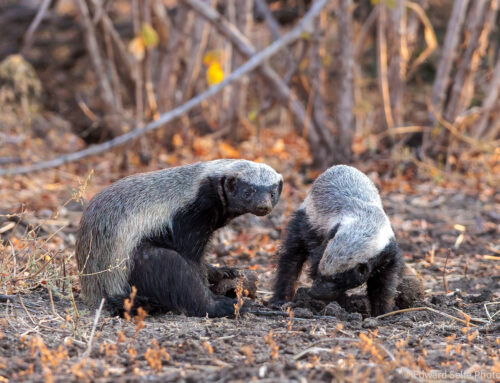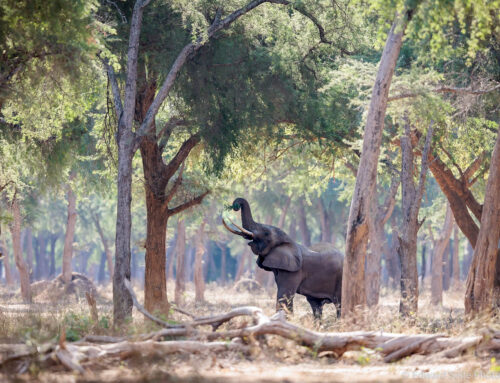I still can’t quite believe that this trip happened! After so many months of uncertainty, changes of plans and rebooking of flights, I only allowed myself to believe it would go ahead when my guests, Michael & Sue, actually touched down in Lusaka! Sadly, my third guests, Debbie, was not able to travel from Australia to join the trip and we missed her presence on many occasions during the 2 weeks we were together. However we explored, enjoyed wonderful wildlife & scenery and revelled in the chance to be travelling once again.
Both my guests had been double-vaccinated before leaving USA, and I had received one dose. My second was due just before the trip started, but a delay meant that did not happen. Sadly Zambia’s rate of COVID was very high at the time that this trip took place. This meant that visitors to the country (especially vaccinated ones) posed no greater threat to people here than anyone else. We followed all required precautions and always wore masks when indoors to ensure that we did not contribute at all to the spread. Even if any measures can feel futile when infections rates are running at 30-50%, we wanted to be sensible. The guests both received negative tests at the end of the trip, suggesting that we had succeeded in this goal, and indicating that the lodges’ efforts to implement covid-spread prevention are effective…well done and thank you to them!
This is a trip that I had been very much looking forward to; the chance to spend 2 weeks with career scientists, with field experience from across the world, as we explored some of the lesser-visited parts of Zambia. They wanted to revisit Luangwa at a different time of the year (July versus October) and to see some other parts of Zambia. The suggestion of searching for the bizarre but wonderful Shoebill stork on the Bangweulu swamps was immediately added to the itinerary and, while we were in the central part of Zambia, we decided to add visits to Mutinondo Wilderness area and Kasanka National Park to the trip.
We started early from Lusaka in a comfortable stretched Landcruiser with large windows and plenty of space for cameras! Our first destination was Forest Inn, an overnight stop about 5 hours north of Lusaka in the farming area of Mkushi. The route takes us within 10kms of a reliable site for Chaplin’s Barbet (one of Zambia’s 2 endemic bird species) so we deviated to search for it. Initially, there was no sign of the birds, despite the habitat being spot on, but eventually, we found several families calling from the top of their sycamore fig tree-homes. They live in extended families of 6-8 birds and require the dead branches of fig trees to excavate their nests; this limits their range and makes them a Zambian speciality which is sadly classified as Vulnerable due to habitat loss. The African Bird Naming Committee is currently implementing a name change to Zambian Barbet to recognise its endemic status.
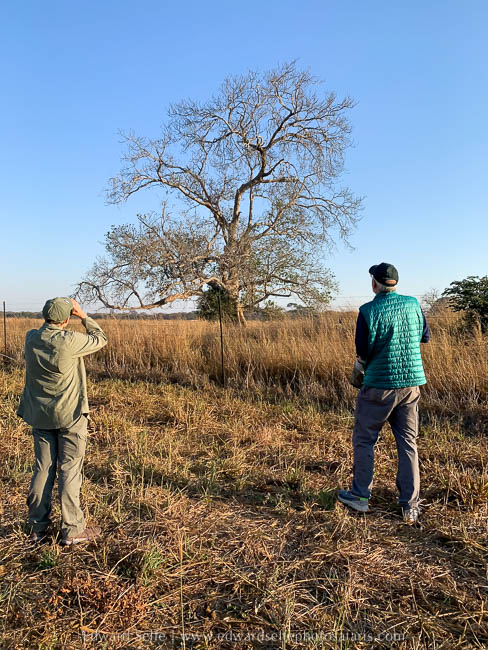
Watching and photographing Chaplin’s Barbet at the roadside in Chisamba.
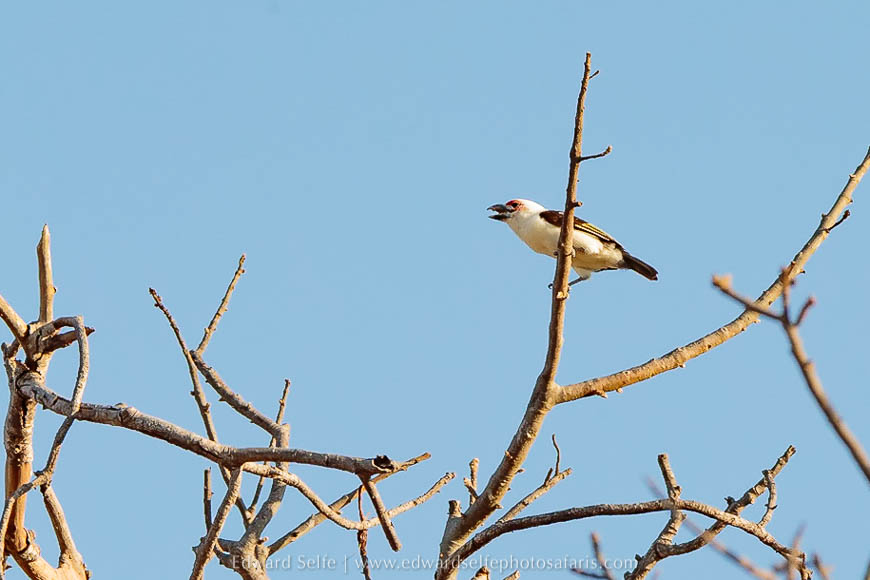
Even with long lenses, they were a little distant, but it was great to watch them chattering and calling together.
We continued to Forest Inn, stopping for some sights along the way, and spent a happy afternoon photographing the amazing array of birds and insects in the beautiful grounds of the lodge. There are also occasional sightings of a ‘flying squirrel’ (Anomalurus sp.) at a tree-hole near the entrance gate, so we sat for 2 hours in the evening hoping it would emerge. Sadly, it seemed to be using a different hole that day as it didn’t appear…but, fortunately, that turned out to be the only ‘miss’ of the trip!!
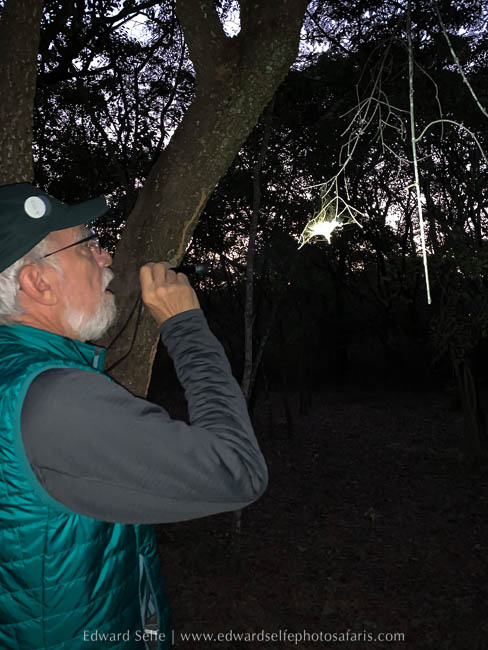
As career entomologists, it was fascinating to spend time with this couple as we searched for insects in the dark around the grounds of Forest Inn.
On route to Mutinondo the next day, we took a detour to visit the very pretty Kundalila Waterfall just east of Serenje town. Here the rock strata have been upended and the water cascades down between the vertical fissures. Beyond the falls, there is a wide view towards the valley below. Walking around the grounds of the car park, we found a tree full of flowering mistletoe which was heavy with nectar- and insect-eating birds; eastern double-collared sunbirds mixed with white-tailed blue flycatchers and yellow white-eyes in the feast.
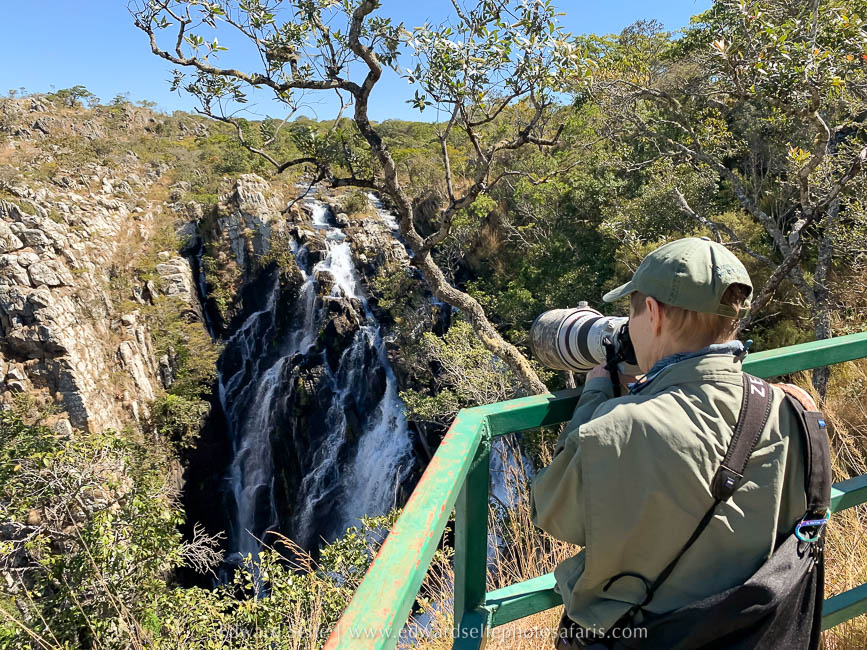
Sue overlooking the falls, doing some textures and slow-shutter-speed shots with her long lens.
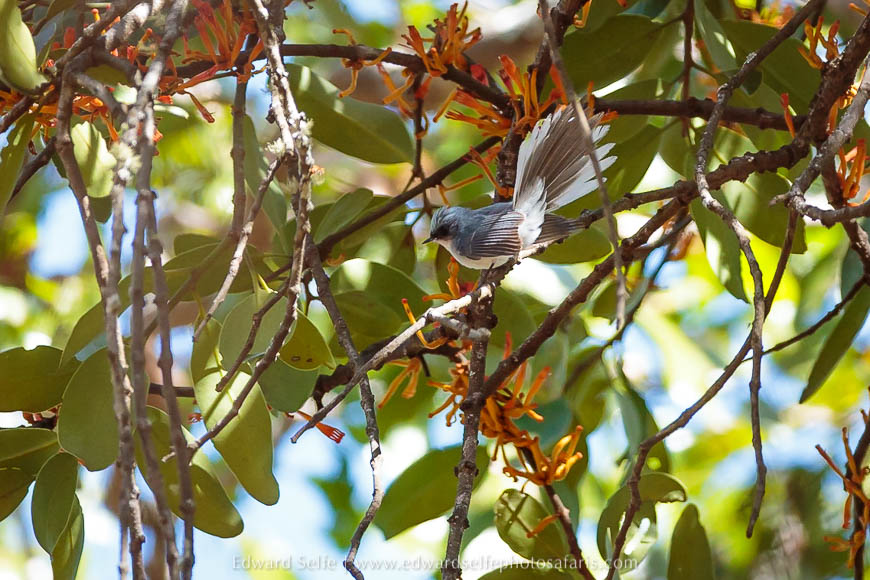
A White-tailed Blue Flycatcher among the laranthus flowers.
It was a long day — Zambia is a huge country and the roads are rather slow — so we arrived at Mutinondo only late in the afternoon just in time to walk along the Musamfushi River close to the camp. Flowering throughout the area were conspicuous, and somewhat incongruous, bright red aloes. In an area where the grip of the dry season had stripped the colour from most of the vegetation, the succulent aloes appeared to glow in the winter sunshine.
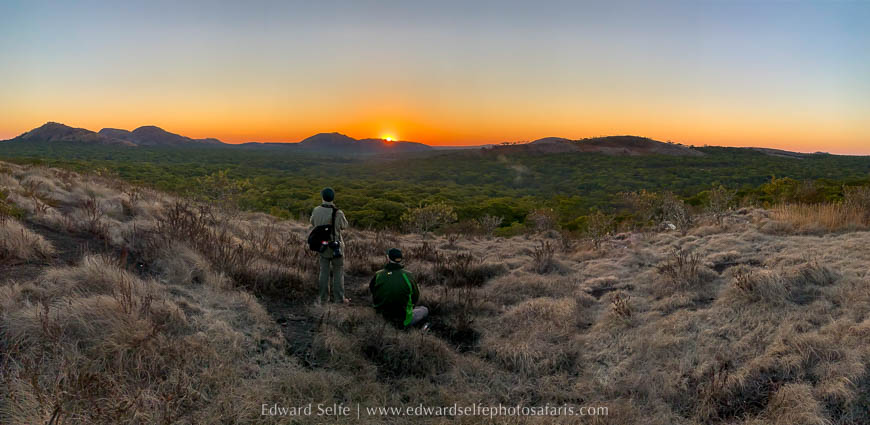
Our first morning in Mutinondo — we walked to the top of one of the inselbergs to enjoy the sunrise over the forests. It was cold so the camp’s supply of hot tea was very welcome!
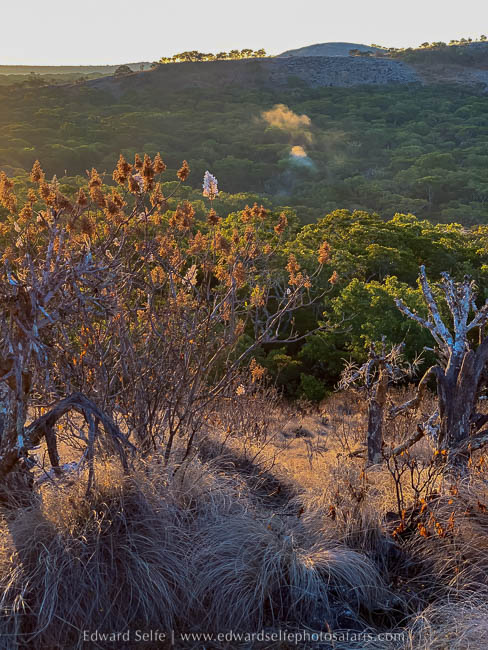
As the sun climbed, the backlight effect on the trees made beautiful images; in the distance the spray of one of the waterfalls is visible.
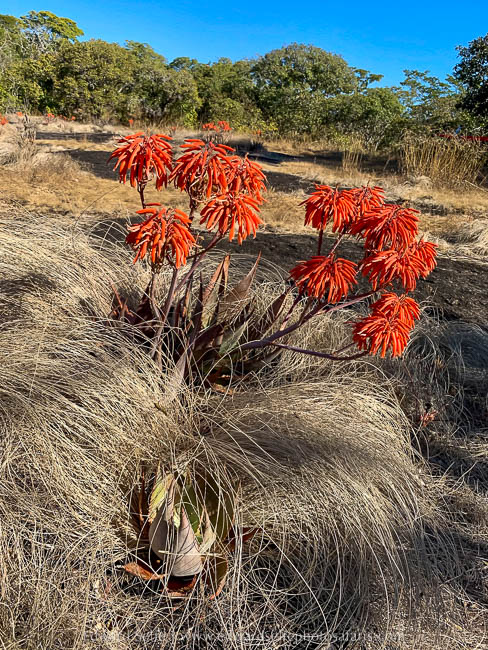
Blossoming in the most unlikely places, these aloes were a constant pleasure to us as we walked the trails around Mutinondo in search of butterflies, birds and a repeat sighting of the large roan antelope we had seen on our way in!
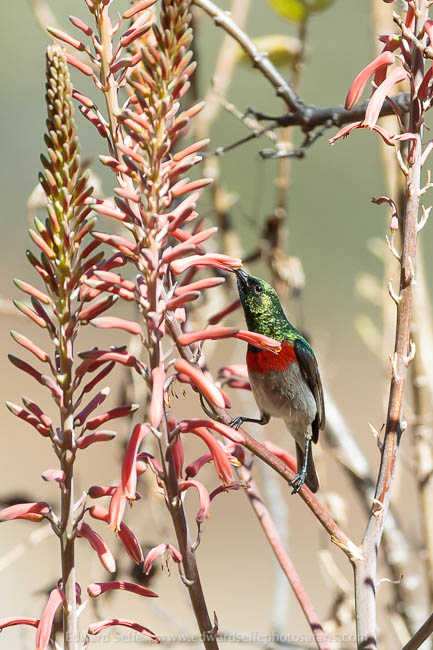
The colours of this sunbird appear metallic in the bright sunlight.
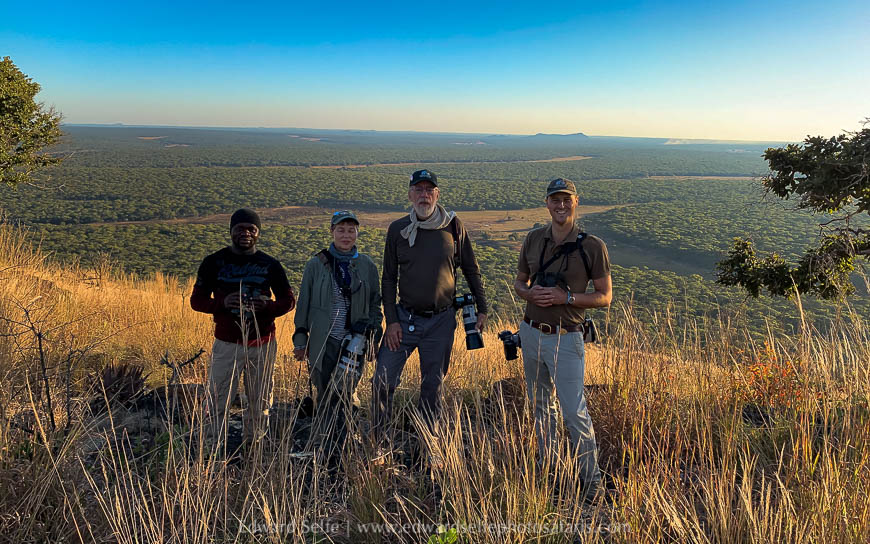
Group photo on top of Charlie’s rock with Ruston our driver/guide for the first part of the tour.
It had certainly been cold in Mutinondo and the bird- and insect-life had been somewhat subdued. However, Sue and I had a close up and personal experience with an African Broadbill (see video at the end of this blog) which made up for that. However, the cool days meant we could explore for longer each morning and we certainly enjoyed the multitude of sunbirds available in the miombo woodland. Besides, the primary target for the trip to this central area of Zambia was the shoebill stork and we had planned the timing of the trip to be in Bangweulu at the best time for that.
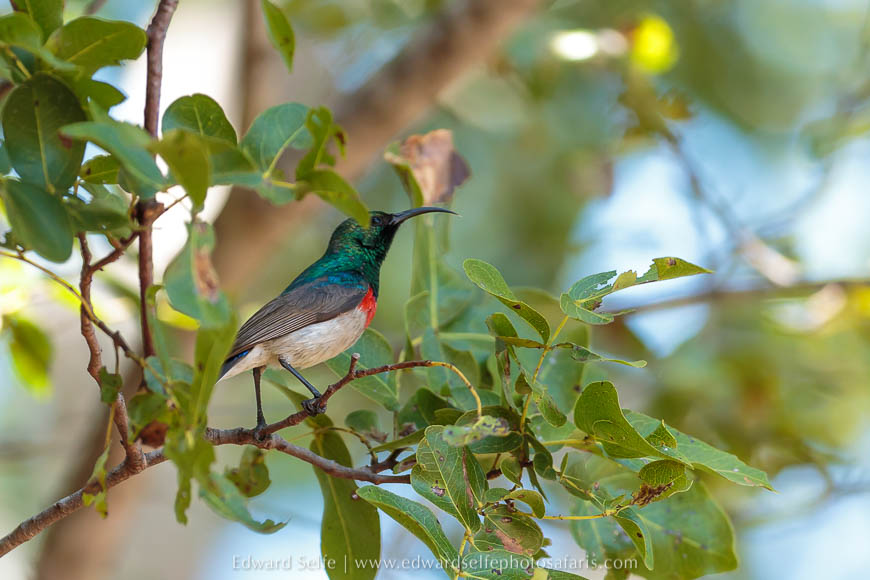
An Eastern Miombo Sunbird near the camp’s restaurant area.
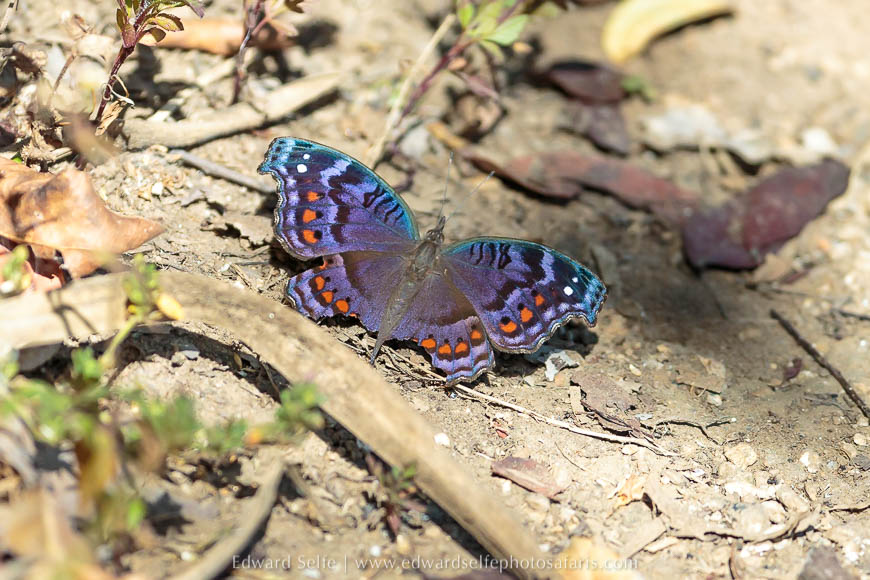
A gaudy commodore butterfly resting in the warm sunshine.
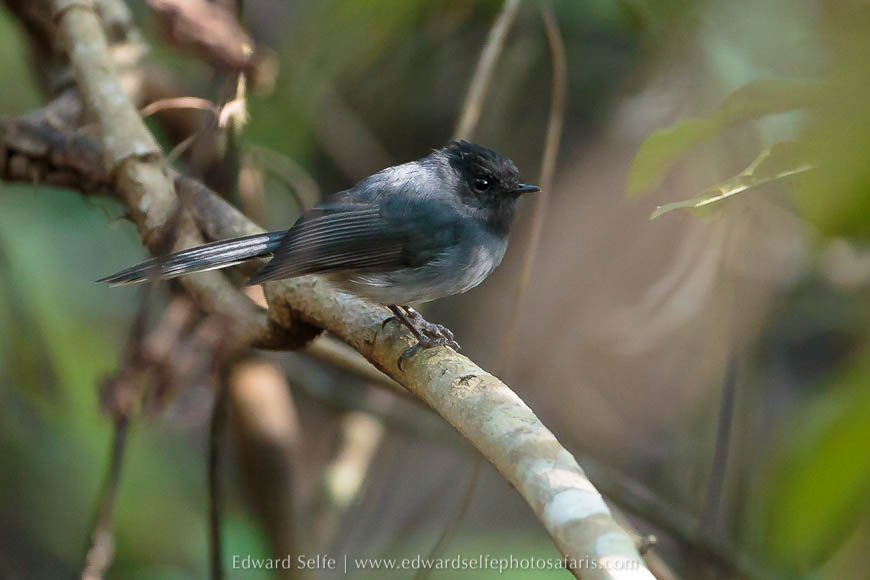
In the depth of the dark mushitu woodlands, we eventually managed photos of this white-tailed crested flycatcher.
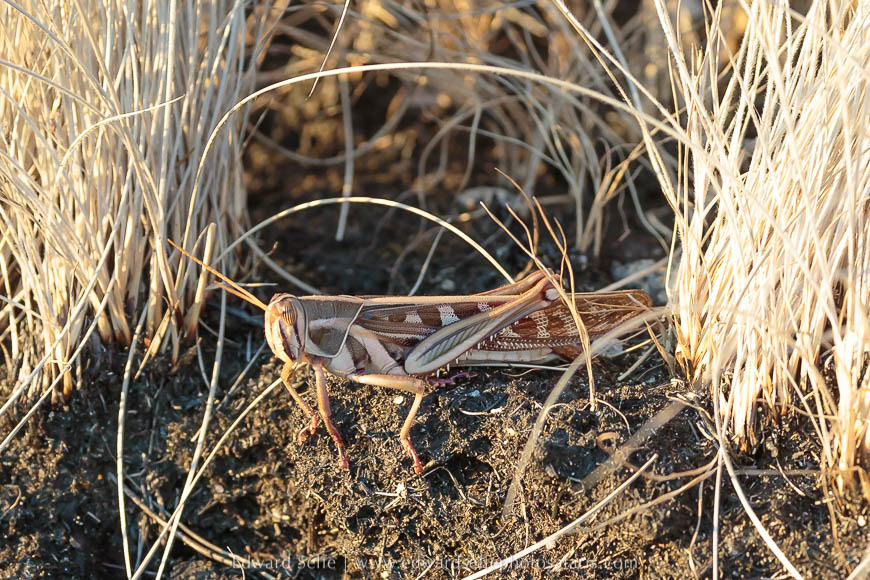
A very large grasshopper! They show bright pink under the wings when they fly, but then disappear in the grass when they land. We finally got photos before this one flew off again!
After 2 nights at Mutinondo, it was time to move on to Kasanka National Park to track down sitatunga antelope and add to the bird and insect lists for the trip. Kasanka was an easy 4 hour drive from Mutinondo, mostly along the Great North Road. Being a field biologist, Sue keeps field notes which she works up into a daily record of the trip which then informs a full journal/scrap book which she writes back home. She spent the road journey converting her shaky field notes into memories. I really admire this process not least because it is a reminder that I too often enjoy something and then move on, rather than really forging those moments into memories and experience. Partly that is down to the nature of my work; guests’ time is short and we seek to fit in as much as possible. But over a season, where there are often just a couple of days between each trip, some of the more subtle moments from each trip, where I don’t or can’t take photos, are likely lost from my memory. I used to make field notes and this has spurred me to do so again.
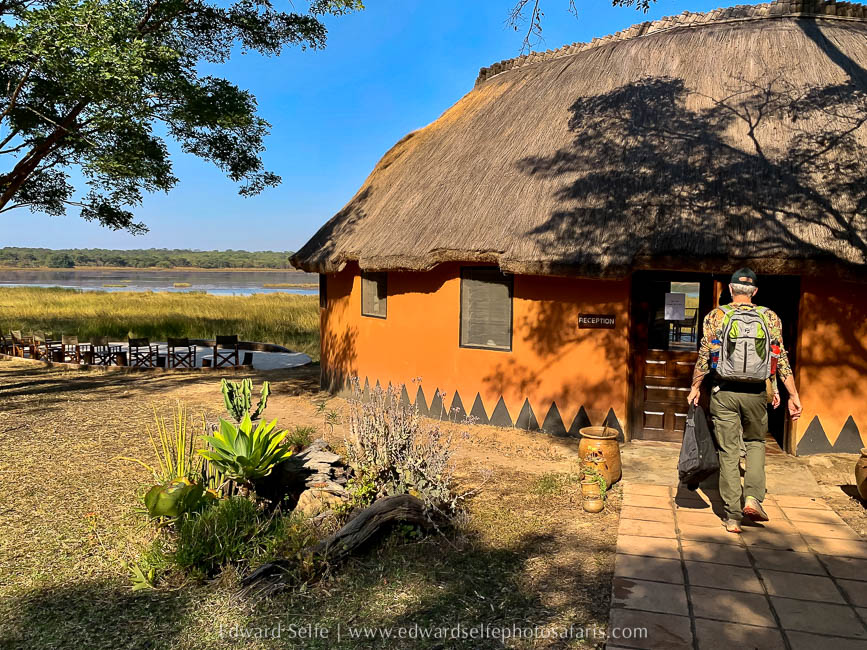
Arriving at the simple but comfortable lodge on Lake Wasa in Kasanka.
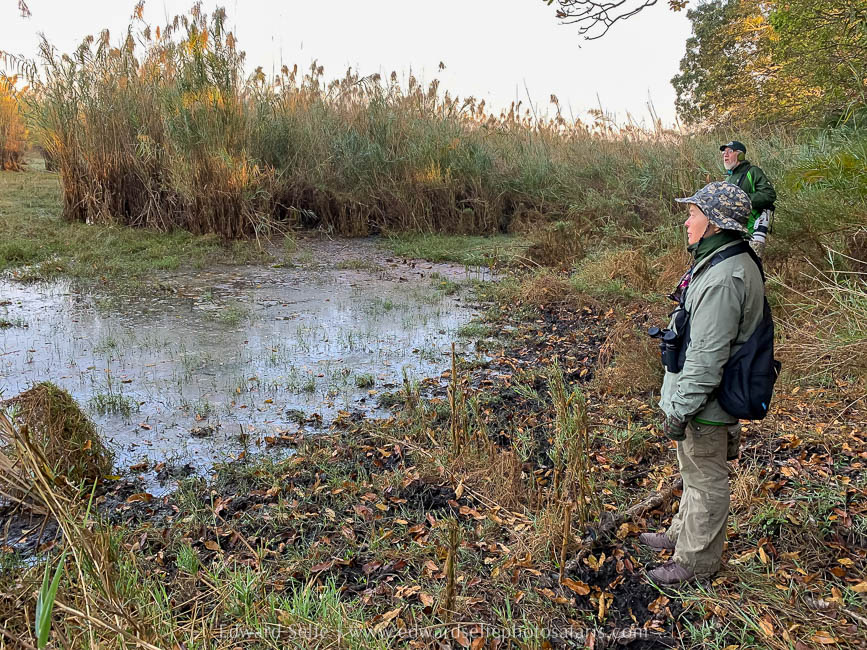
Early the next morning we were out at the pontoon crossing over the Kasanka River in search of sitatunga.
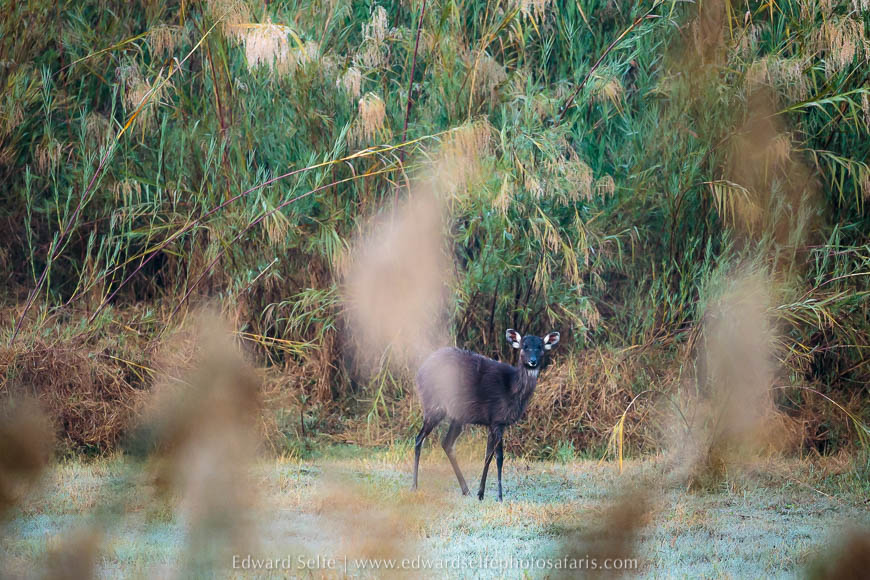
These are famously shy and difficult antelope, usually requiring high hides which you must enter before dawn. But in Kasanka, there is a healthy population which has become very familiar with people which makes it the best location anywhere to watch these special creatures.
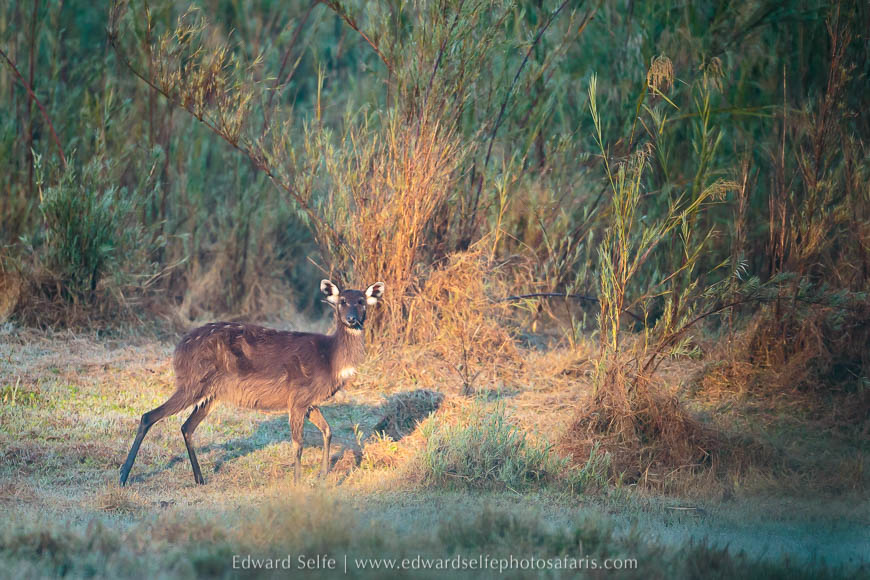
With long powerful back legs, and long, splayed hooves, they are well adapted for life in the marshes. In fact, hard, dry ground is very uncomfortable for them, so they are confined totally to the swamps in the dry season. A relative of the bushbuck, they rely on that family’s large ears and keen sense of smell to advise them of danger, and they are surprisingly agile in their flight for cover when alarmed.
We also wanted to photograph some of Kasanka’s impressively diverse birds; most notably the Bohm’s bee-eater. We spent quite a bit of time with these birds allowing them to settle so that we could get very close.
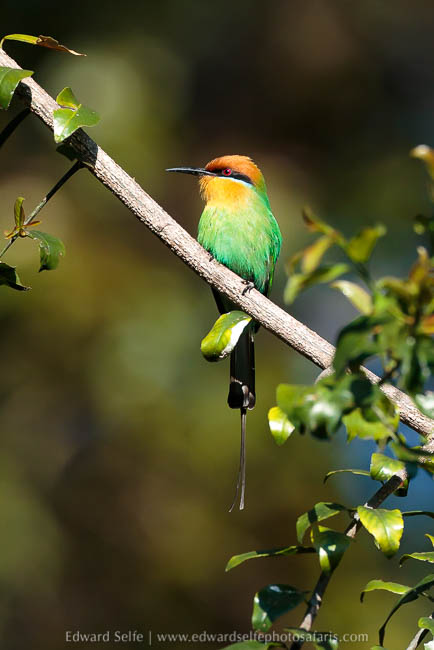
Such a beautiful bird. It was great to see it so well, but to get images like this was a treat.
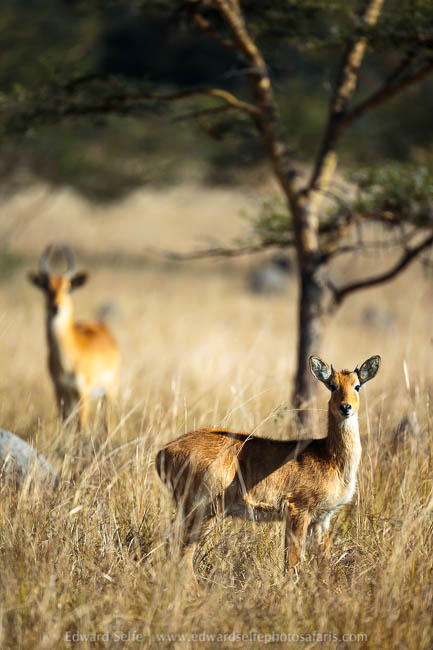
We also spent time following the Kasanka River floodplain, where the habitat is beautiful.
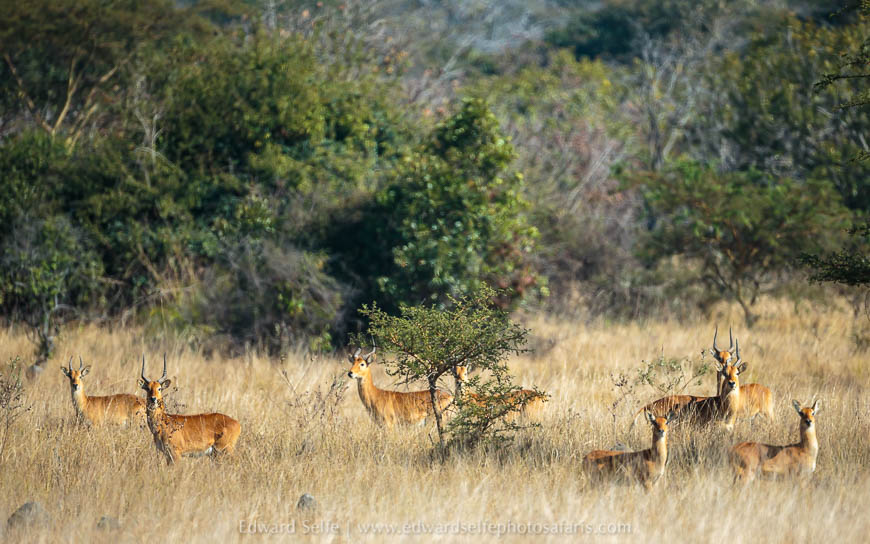
The flight from Kasanka to Bangweulu was fortunately smooth and uneventful (for those of us who love small aircraft but not the way it makes us feel!) and we enjoyed the short flight over Kasanka which the pilot gave us as a bonus – thank you Sky Trails!
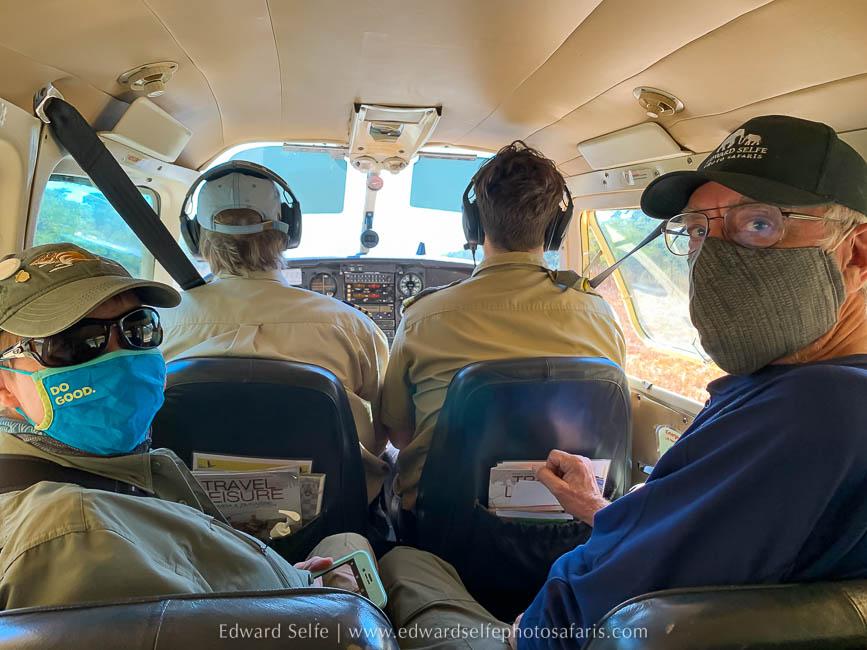
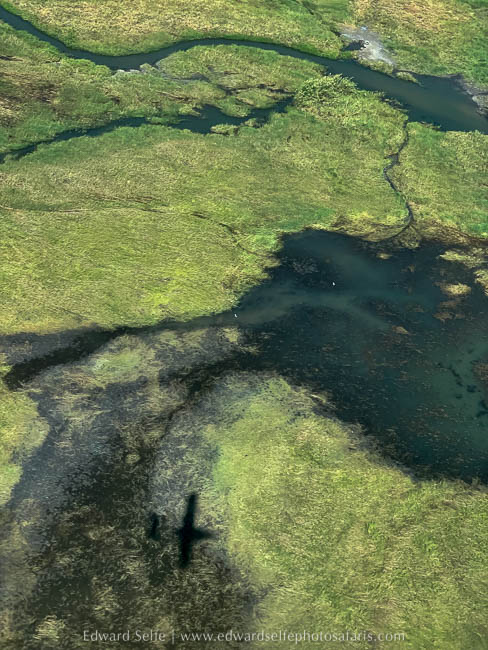
Looking over the Kasanka River floodplain.
We knew that our time in Bangweulu was going to be fantastic from the moment the pilot told us that we would not be able to land at our planned airstrip (on the edge of the swamps) because it was still flooded! This meant that the water levels were still very high which would make exploring the swamps easier and more rewarding. We happily accepted the slightly longer road transfer that would be required to drive from the new airstrip to the edge of the swamps. This also retraced the route that I had taken before and I remembered how much I enjoyed driving out from the woodland on to the plains and revealing the thousands of lechwe that live there.
Crossing the plains, we passed through herds of thousands of lechwe, and flocks of Vulnerable wattled cranes. We planned to spend a day on the plains, exploring the grassland and woodland fringes, but first there was a day and a half in the swamps looking for Shoebill storks! We drove as far as we could, leaving the vehicle on the plains, and met the team from camp who helped us carry our kit to the fibreglass canoe. We poled (no engines here!) along deep channels from the edge of the plain to the front door of the camp — wonderful!
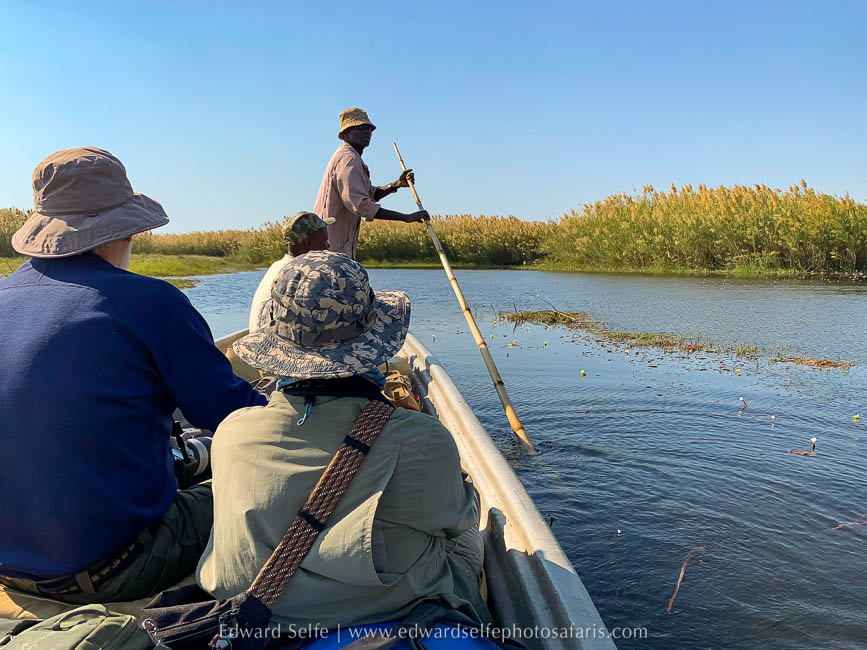
Setting off from the ‘car park’ towards camp!
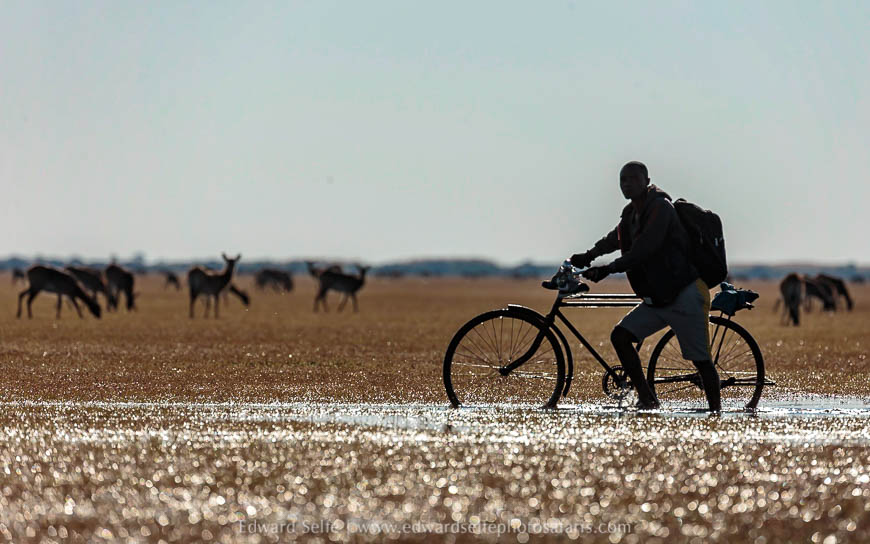
The Bangweulu Wetlands is a community-owned wildlife area; there are a number of fishing villages nearby and the people co-exist with the lechwe and the birds of the swamps. The management of this fragile arrangement is in the hands of African Parks. While I remember seeing fishermen the last time I visited, the human population appears much larger this time and I wonder about the sustainability of the fish resources when it is the only source of revenue for the growing population of the area.
Even on the way into camp, we were overwhelmed with the sights and sounds all around us. From every stand of phragmites reeds, and every clump of papyrus, came a diverse array of sounds; clicks, whistles, insect-like trills and enticing splashes as birds and small mammals moved around. Over the first couple of hours, we reacquainted with the lesser swamp warblers, chirping cisticolas, black crakes, little rush warblers and swamp flycatchers who make up this symphony.
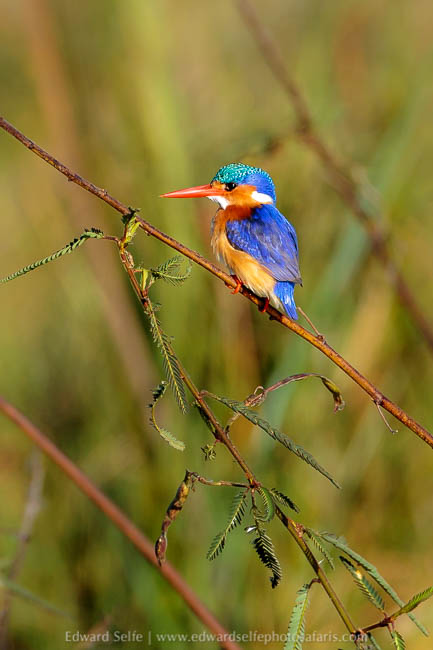
After a very long day of travelling, we took a short afternoon boat safari through the reeds and papyrus beds around the camp. We spent time with malachite kingfishers (there’s no better way to get close to these lovely birds)….
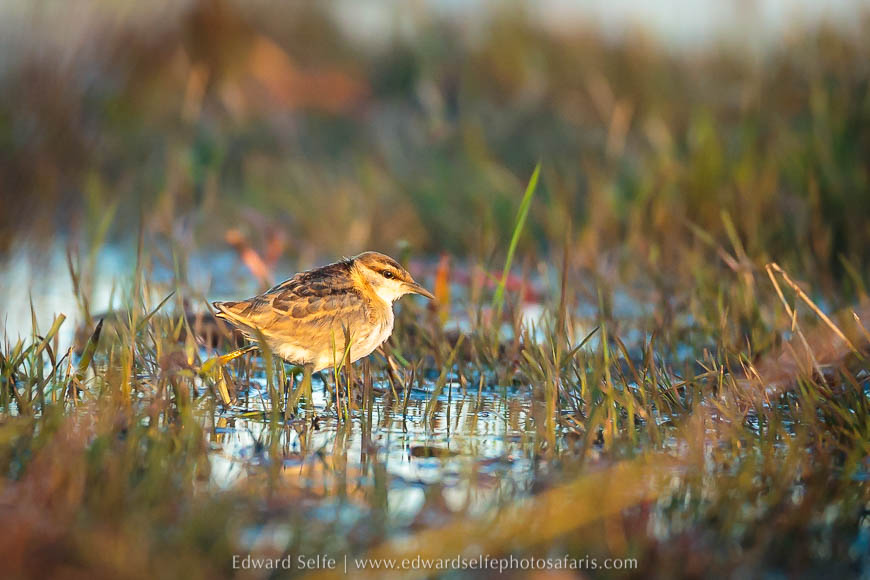
….and were fortunate to get clear shots of a lesser jacana, the uncommon relative of the well-known African lily-trotter.
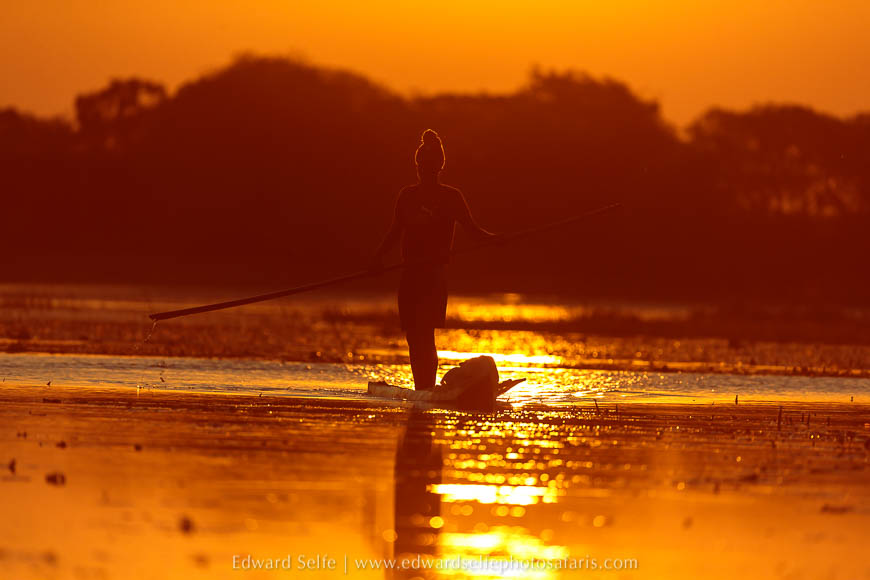
As the fishermen headed home, so did we, knowing that we had a big day of shoebill searching the following morning!
Early the next morning, we were in the main area of camp bright and early ready for the new day. The sunrise was spectacular over the swamps, especially in the 30 minutes before the sun broke the horizon. The range of oranges, yellows, pinks and reds was stunning. As we watched, a large herd of lechwe, which come deeper into the swamps at night to feed, started to cross the wide, flooded channel in front of us…. We had cameras at the ready, and set up for any kind of action, so we got wonderful shots of the herd splashing through the deep water.
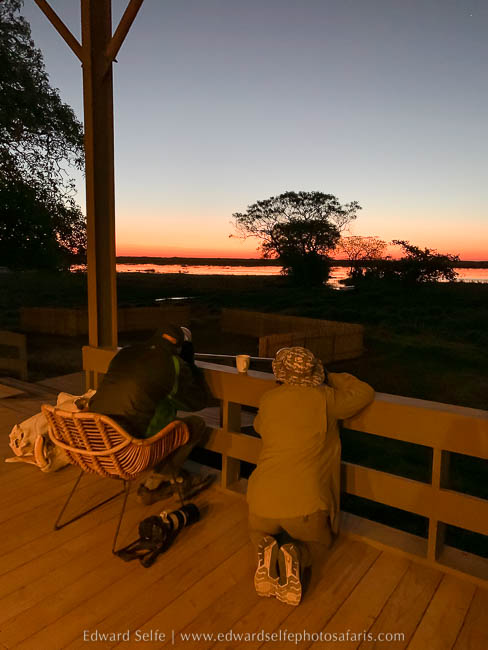
Using the guard rail as a camera support, we prepared for the lechwe crossing!
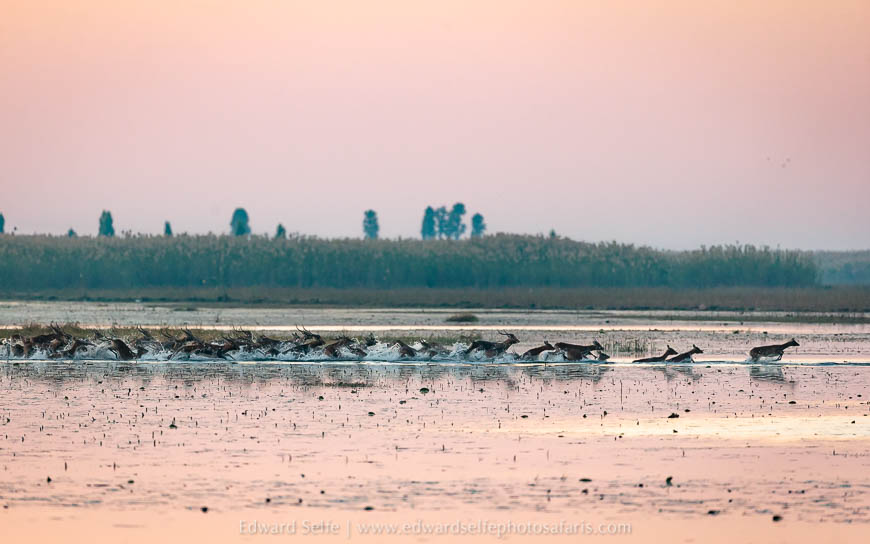
Lechwe are highly aquatic, thinking nothing of charging into deep water and swimming through when necessary.
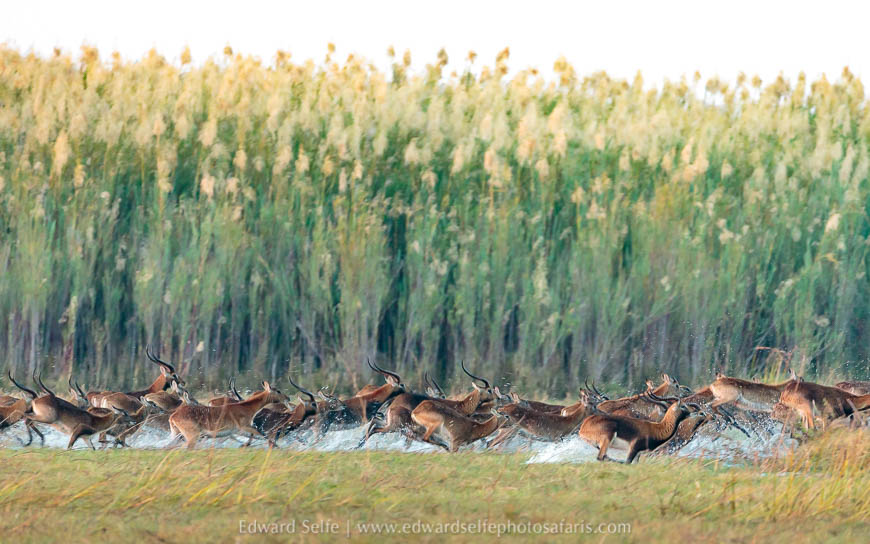
The herd continued to run around behind the camp, with the light behind them, allowing shots with a completely different feel.
That first morning search for shoebills was rather quiet in the stork department…! We searched, talked to fishermen and searched some more. There were vague descriptions of having seen one “over there….yesterday…” but no current info. I guess shoebills can also melt into the reeds in pursuit of their catfish prey and simply not be visible one day. Added to this, we travelled in the pre-breeding time so they are not hefted to any one area at that time. Of course, we had a second day in which to find one, but we had earmarked that day to spend time on the plains with the lechwe and in the shallow water at the edge of the swamp, so we hoped to see a shoebill on the first day. There was no doubt, the shoebill was the priority!
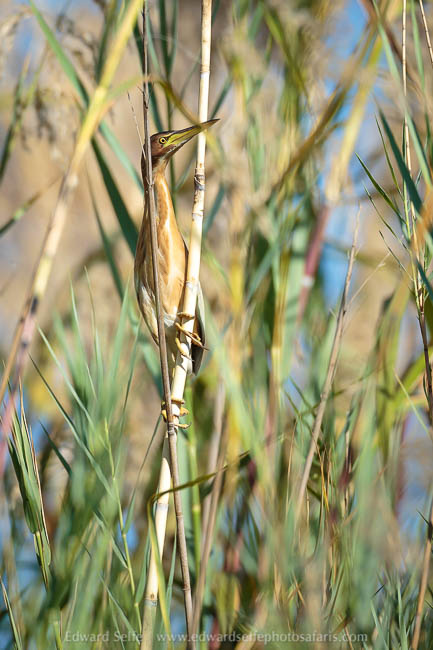
Fortunately, I need not have worried! During our afternoon boat trip, while we were photographing a little bittern hiding in the reeds…
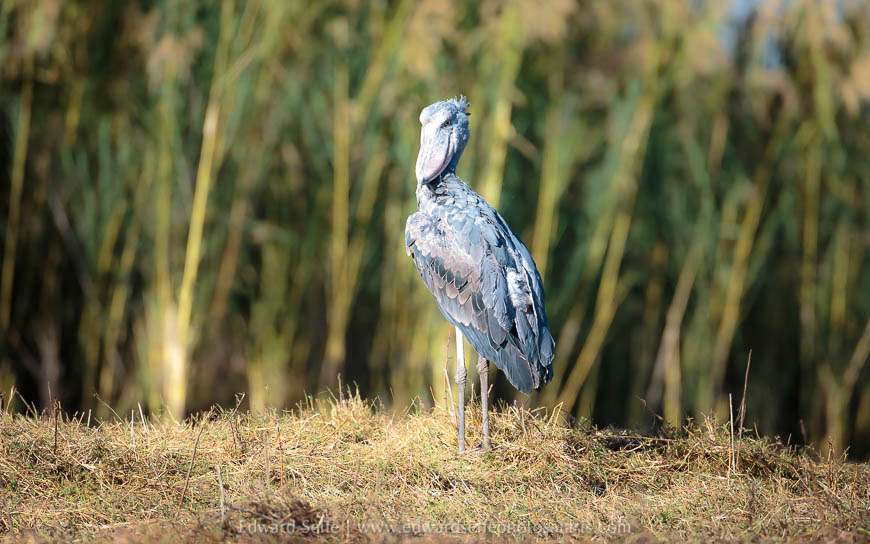
….up ahead of us, a shoebill was spotted preening itself on top of a small mound! Success!!!
It was in a perfect spot for photos. The light was coming over our left shoulder, lighting the bird slightly from the side and leaving the reeds in the background in shadow. It seemed largely unconcerned about our arrival, though we kept our voices to a minimum and didn’t venture too close; we all had long lenses so there was no need to disturb it. While we were close to it, we didn’t talk too much but concentrated on enjoying the view and the photography as much as possible for the 30 minutes that we spent with it.
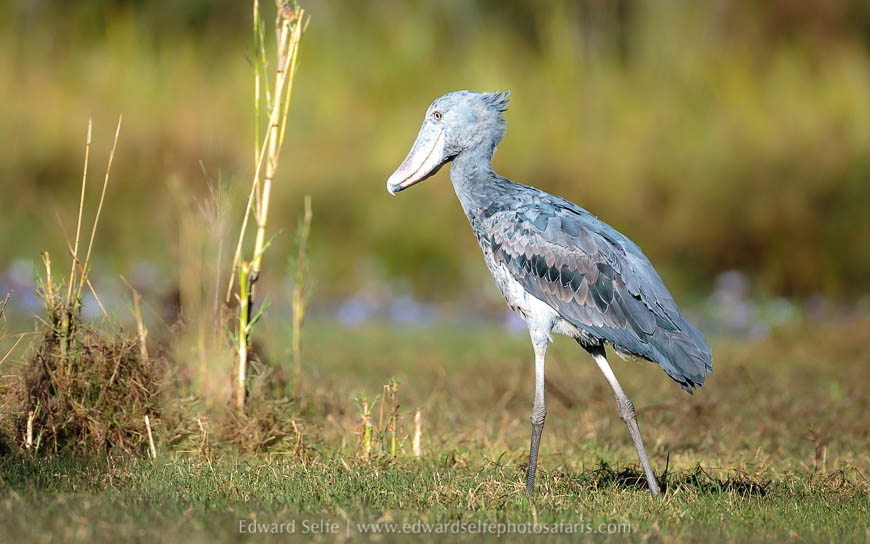
As we started to move away, the bird began to walk towards an area of shallow water, perhaps to start fishing. We shadowed it for a short time, getting some different images and then withdrew 100m or more to watch from a distance.
African Parks have been working with the communities in the Bangweulu Swamps to help protect the habitat and conserve the shoebill. The guides who work in the safari camp are also part of the community education programme and work hard to encourage locals to leave the birds in peace and allow them to thrive. This is especially important in the case of a younger bird like this (some brown is still visible on the wing feathers) which is hoping to establish a territory after reaching around 3 years of age. We wanted to get some great photos of course but we also wanted to help our guide show the best example to the local community by not overstaying our welcome. However, once we had moved back, we were able to watch the bird hunting and chat about it freely. These birds feed mostly on fish (with some other fresh-water creatures also taken) and do so purely by sight, rather than by disturbing the water or combing through the shallows like other storks do. Intriguingly, they are also more closely related to hamerkops and pelicans than to storks and are found throughout central Africa from Sudan to Zambia where suitable habitat occurs. Numbers are quite low at only around 6,000 and Zambia’s 250 is an important percentage of this total.
After such a great sighting of this bird, anything that followed was a bonus! And of course there was lots more to see! During the next day, we spent most of our time out on the plains with the lechwe, but had some great bird encounters along the way.
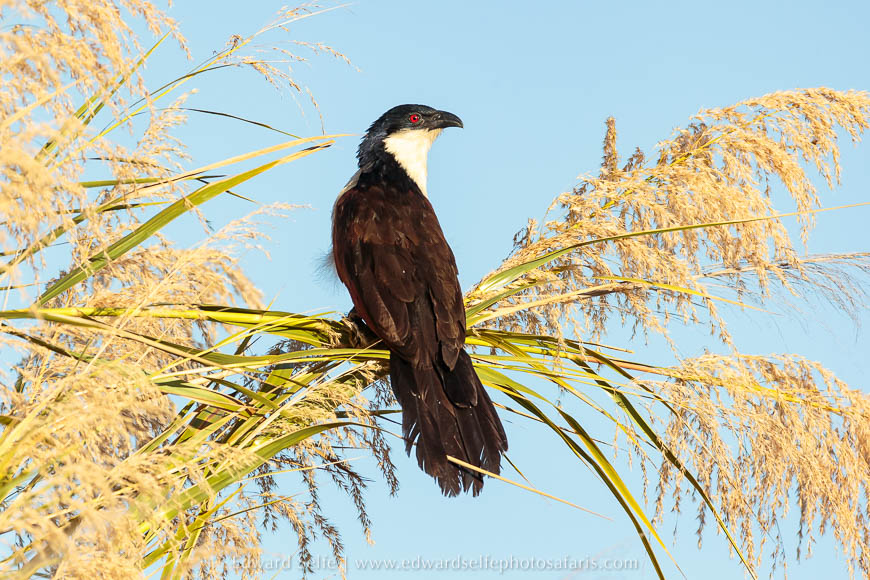
The largest of the coucal species, a coppery-tailed coucal basking in the warm sunshine.
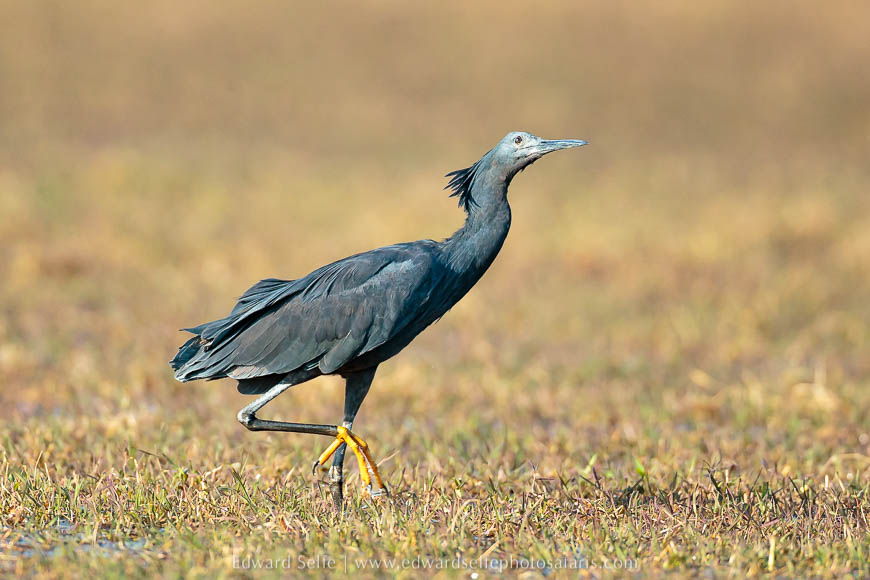
A black heron, known for its umbrella feeding technique, glances skywards as another bird casts a shadow across it.
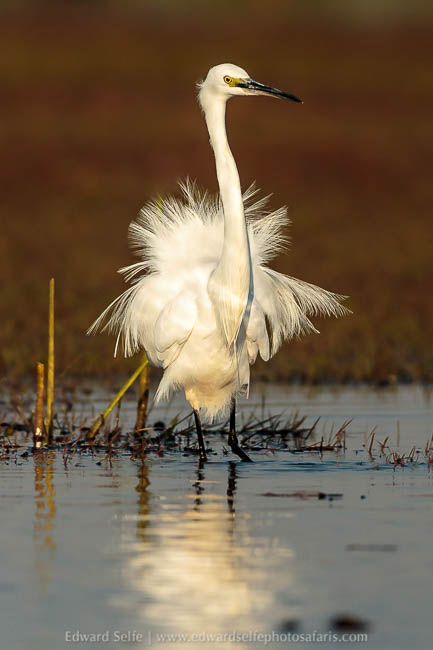
In a show of aggression towards an approaching competitor, a little egret puffs up its fine feathers in a beautiful display.
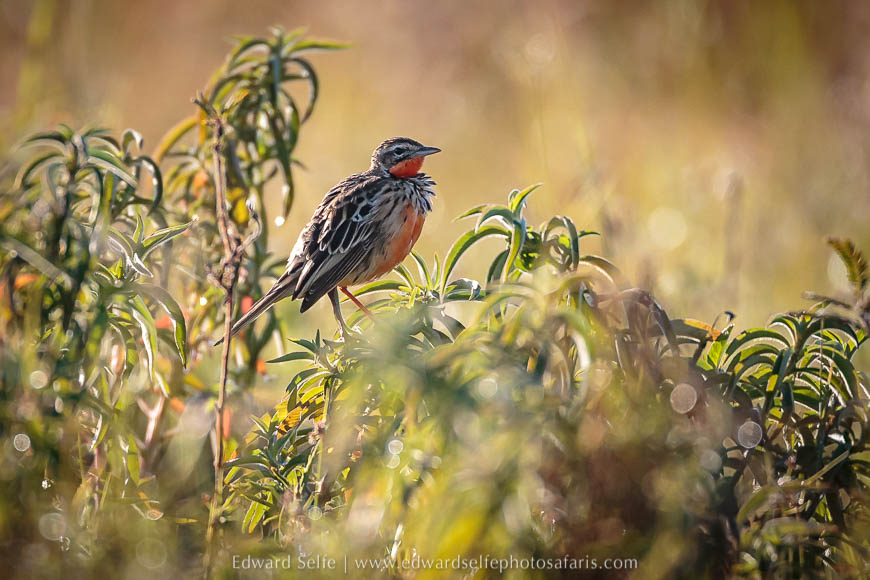
We had expected to see the gorgeous rosy-throated longclaw on the dry grass plains, but it had not appeared. We were happy, but rather surprised, to see it deep in the swamps on a small island!
We had a fantastic day on the plains, with the relief of knowing that we had our shoebill sighting in the bag! Boating to the edge of the lake we watched lechwe feeding in the shallow waters and mixing with the glossy ibises, herons and plovers that also feed in that zone.
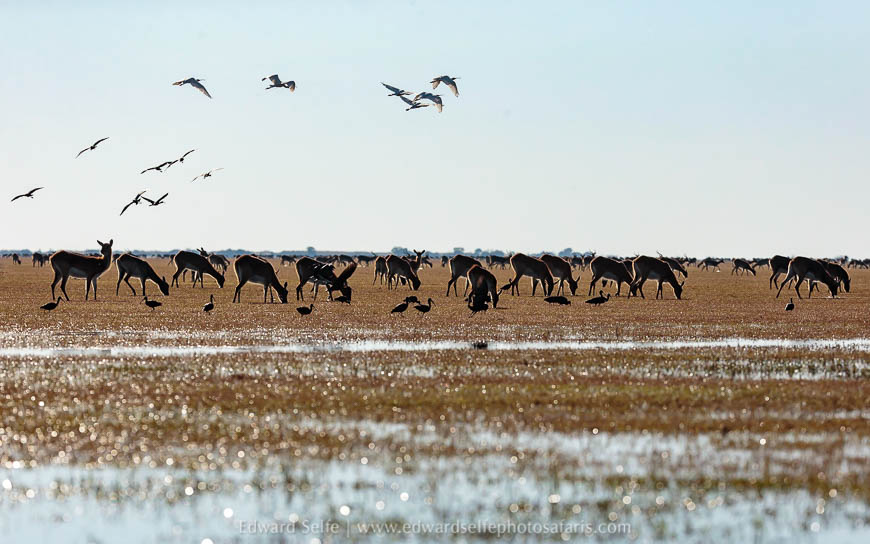
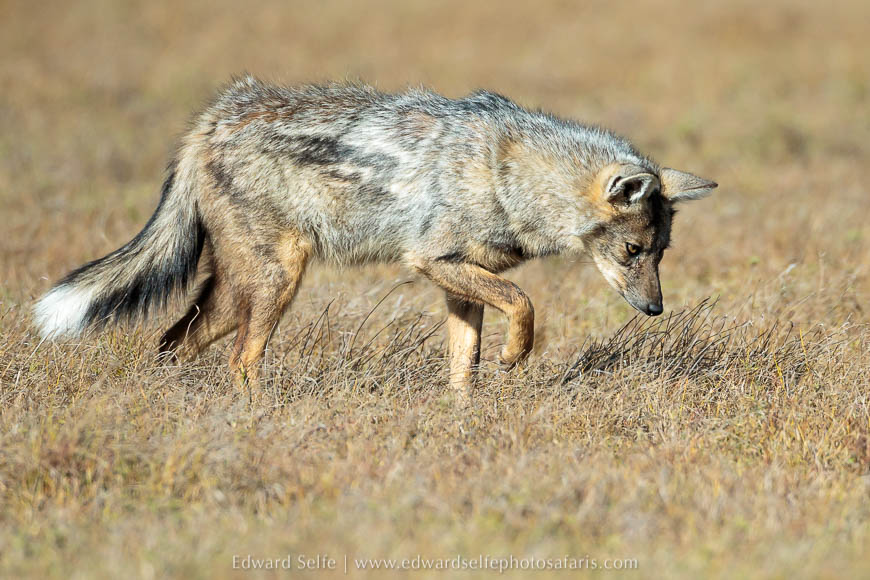
A cold-looking side-striped jackal was hunting rodents and looking for birds’ eggs in the grassland.
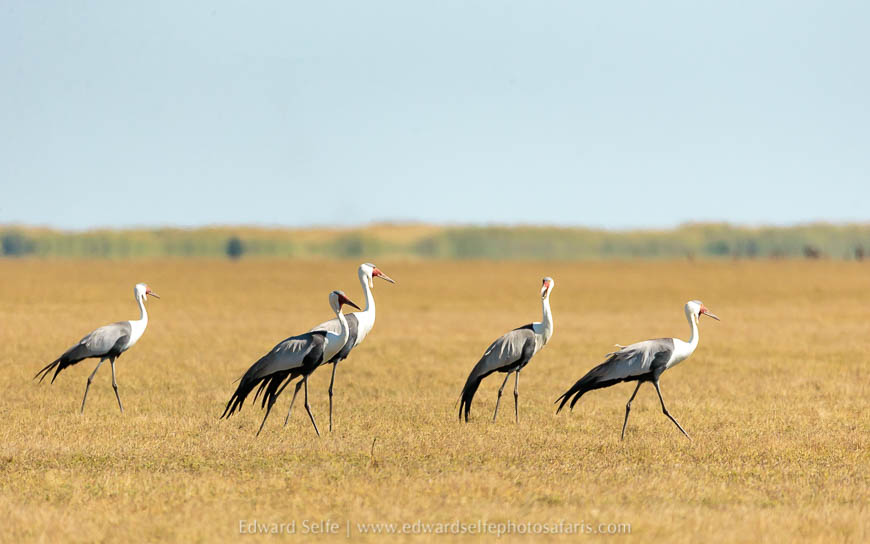
Lake Bangweulu is an important home for Wattled Cranes.
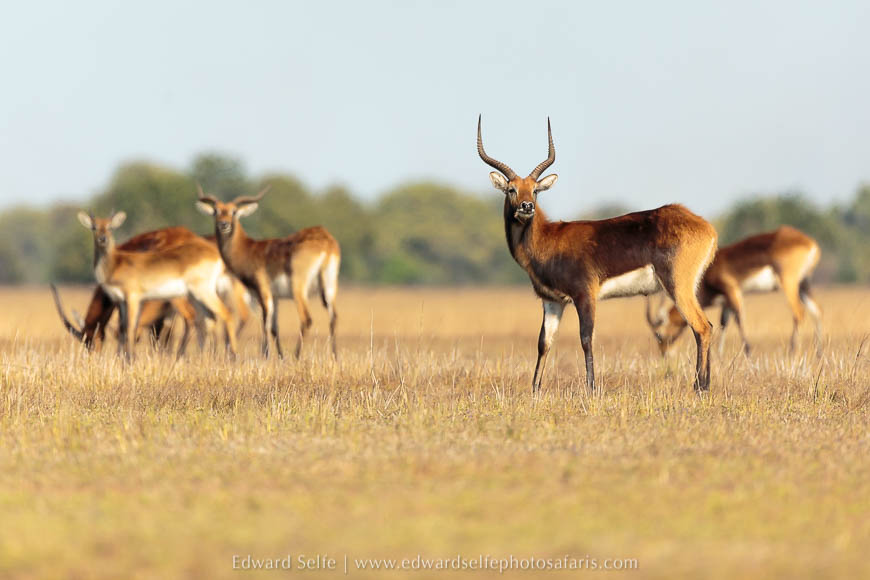
And then there were the lechwe; so elegant and proud. Predominantly aquatic, they don’t cope well on land and are easy prey for hyaena. There are around 50,000 living in the Bangweulu system.
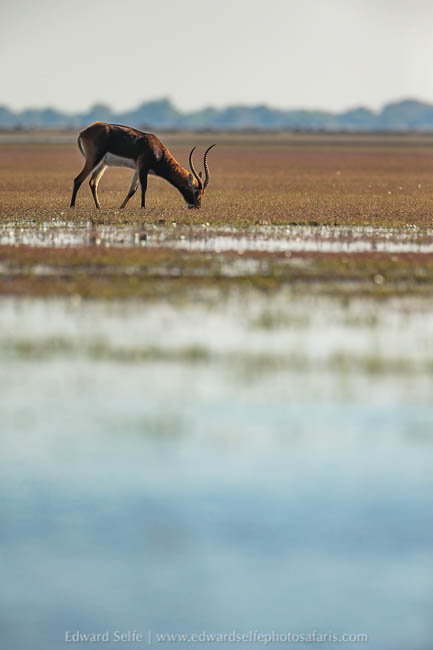
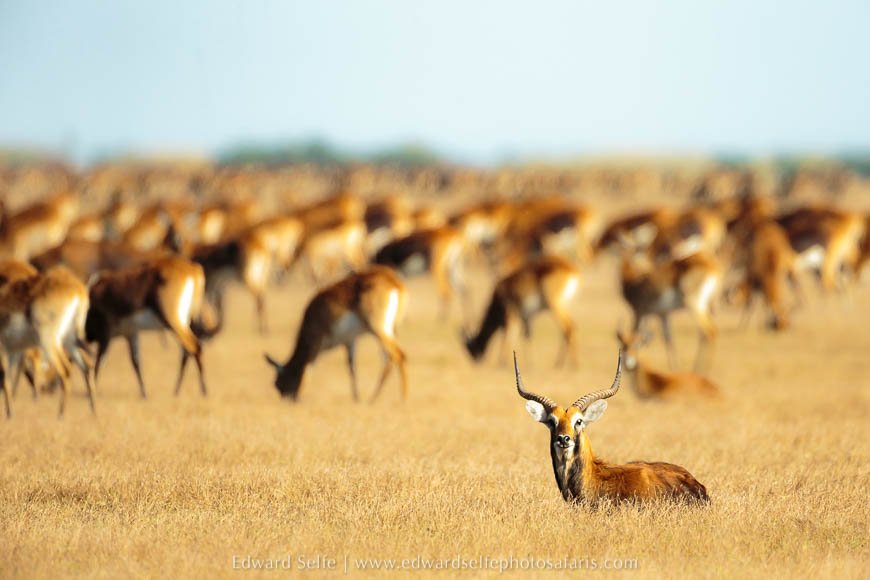
Numbers incalculable stretch away in to the distance.
This ended our time in Bangweulu. The following morning, we took an early boat transfer to the lake edge and then drove back to the airstrip for our flight to South Luangwa where we would spend 5 nights at the superb Lion Camp.
It’s always a pleasure to be on safari in the Luangwa. It’s my home so I always feel very much in my element and I know that nature will deliver one way or another; all we have to do is watch, be alert for the signs and interpret them well. Our first afternoon was unseasonably cloudy and the light was dull, with not too much to see in the immediate surroundings of camp. We struck out further to check on a single hyaena that we had seen under a tree on the way in, and found a small clan of 5 hyaenas squabbling over an old hippo skin! It had been a long day of travel, beginning with a boat transfer at 06.00, 3 hours in the car, 1 hour on the charter plane, 3 more hours in the vehicle and an afternoon drive, so we headed to camp for an early night.
[To add to this crazy day, I had stopped in at the local health clinic on the way from the airport to Lion Camp and received my second COVID vaccine. When the guests heard that there was a chance I could get it on the right day, they insisted that I stopped…many thanks to them for understanding how important that jab was to me and making this possible. In the end, thanks to the efficiency of the staff at the rural health clinic, we were delayed perhaps 30 minutes and we continued to Lion Camp.]
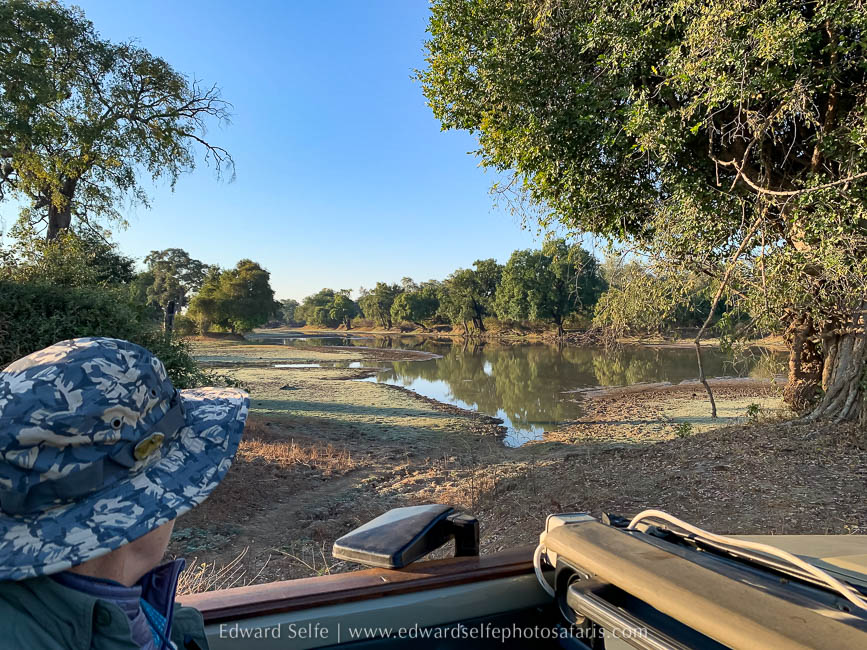
The light and sightings returned to normal on day 2, with this lovely scene at fish eagle lagoon….
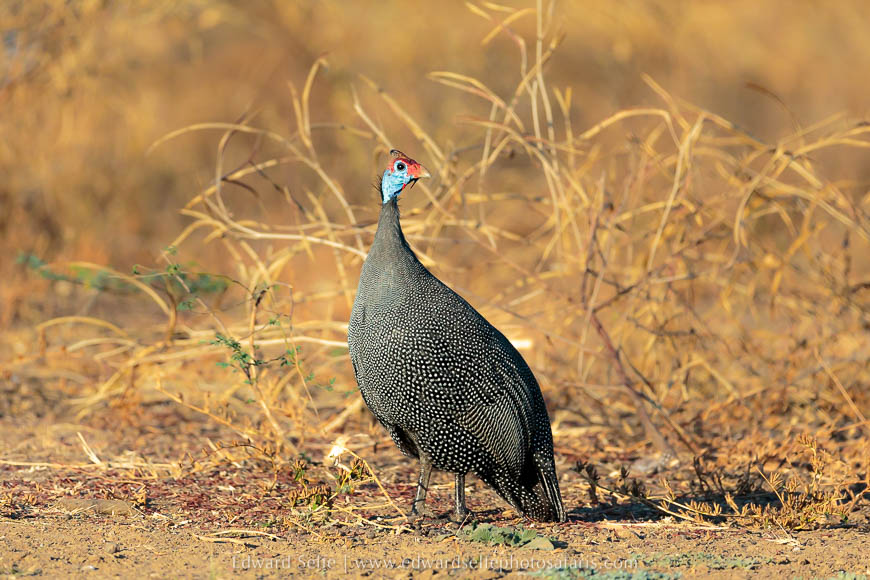
…fun with guinea fowl in the golden light….
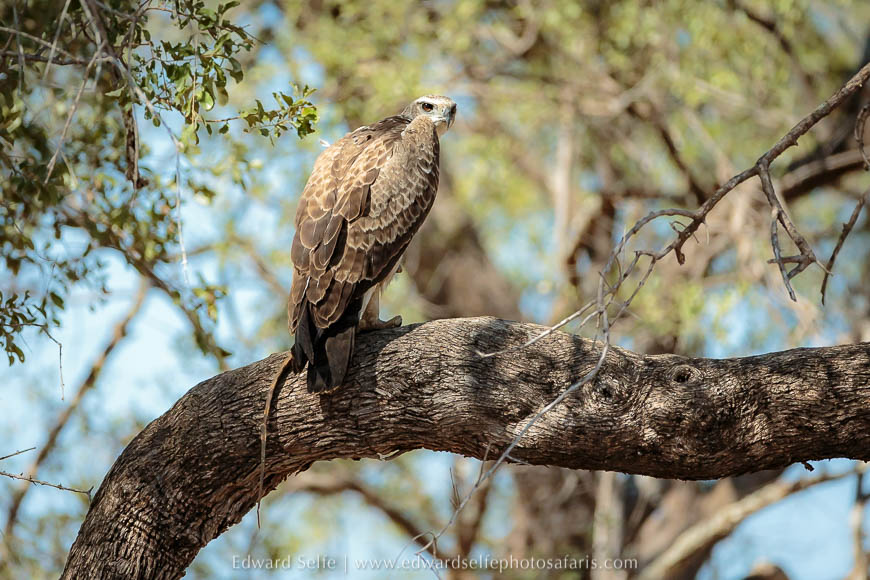
…and a young martial eagle which had caught a monitor lizard – note the long tail hanging down behind the eagle.
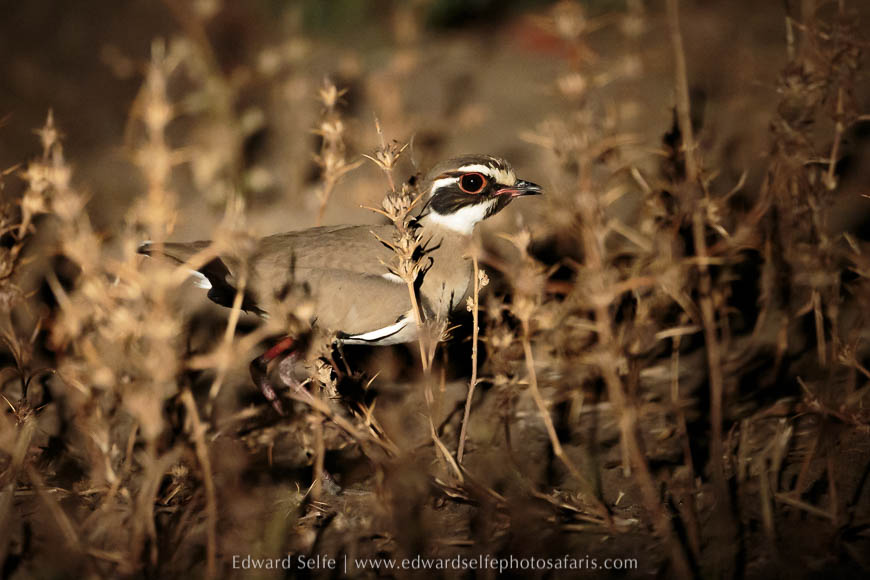
It’s a joy to have birders on safari, as there are sightings and photo opportunities everywhere! Like this bronze-winged courser….
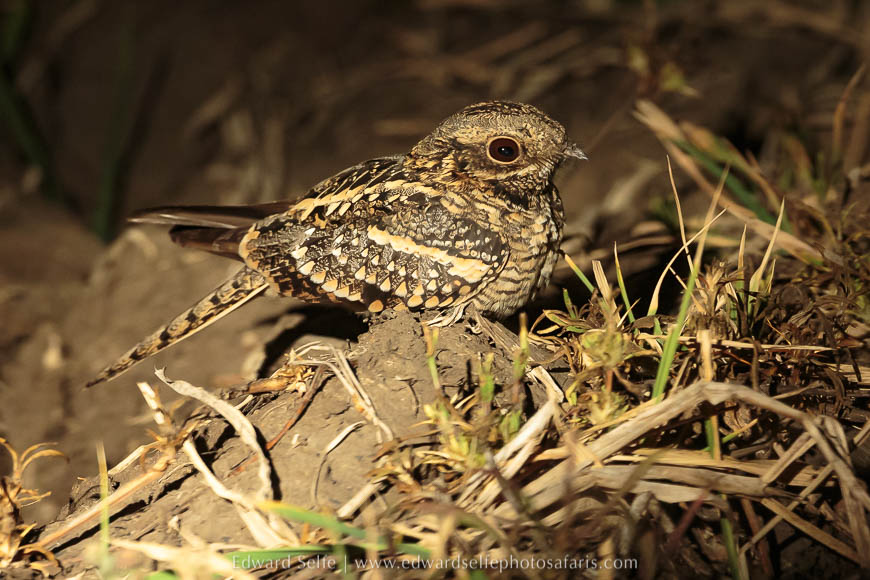
…and a female square-tailed nightjar that we found one evening.
True to their usual form, the lions of Lion Camp (the River Pride, formed from the remnants of the Hollywood Pride) showed up the following morning. With so much inland water, and cool days in winter, the lions occasionally go missing for a few days, but always reappear soon enough! The 6 females have 4 cubs of 2 different ages, so there is always rough-and-tumble to observe!
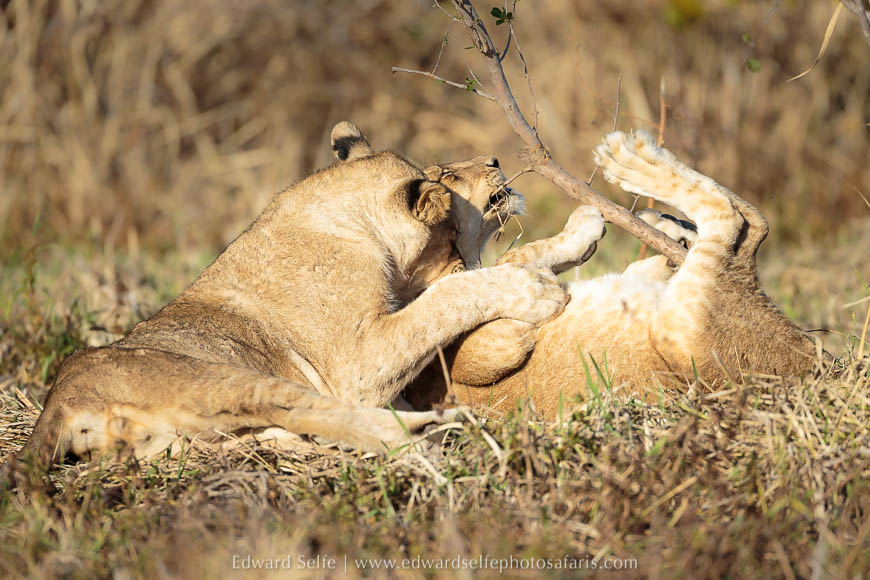
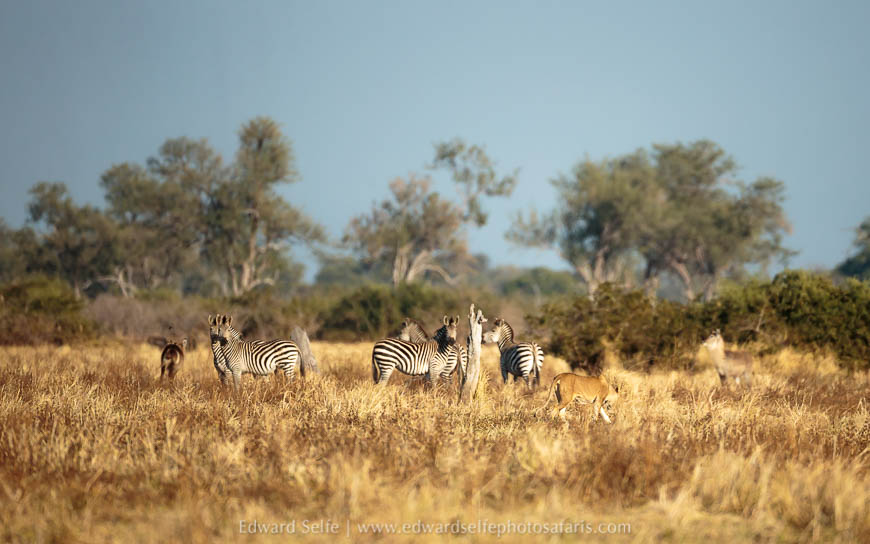
The pride seemed hungry and one of the females went off in search of prey…but soon gave up, the bright daylight making her much too obvious to her targets!
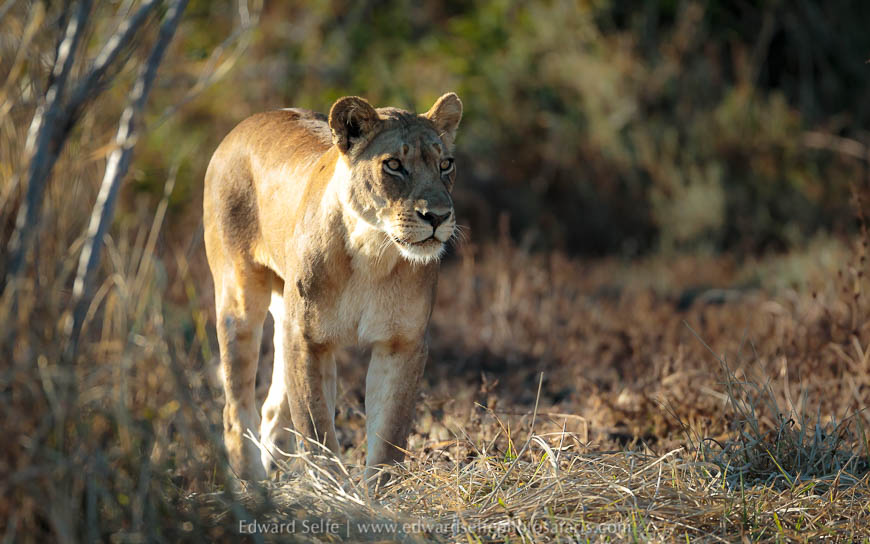
The other females were rooting for her….even if they didn’t go to help!
Over the next 3 days, we explored the whole area, enjoying the cool winter days which enable long mornings and early afternoon departures from camp. One day, we took a packed lunch and stayed out the whole day, returning only after dark. Having the luxury of time allows us the chance to sit, watch and wait for things to unfold. From a guide’s point of view, it is a real treat as it allows us to pursue any and all small signs that the bush reveals without the pressure of worrying that some of them will come to ‘nothing’.
In this way, we had lots of enjoyable encounters, the best of which are coming up:
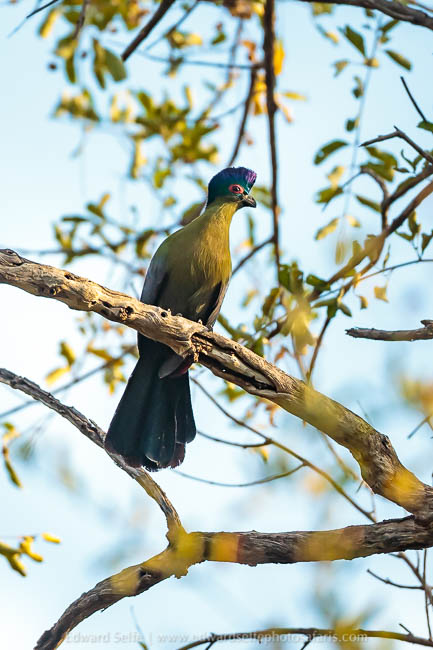
Wtih patience, we managed to get images of purple-crested turacos which were feeding high in the branches of a fig tree. They are highly private and prefer to bury themselves in the leaf cover.
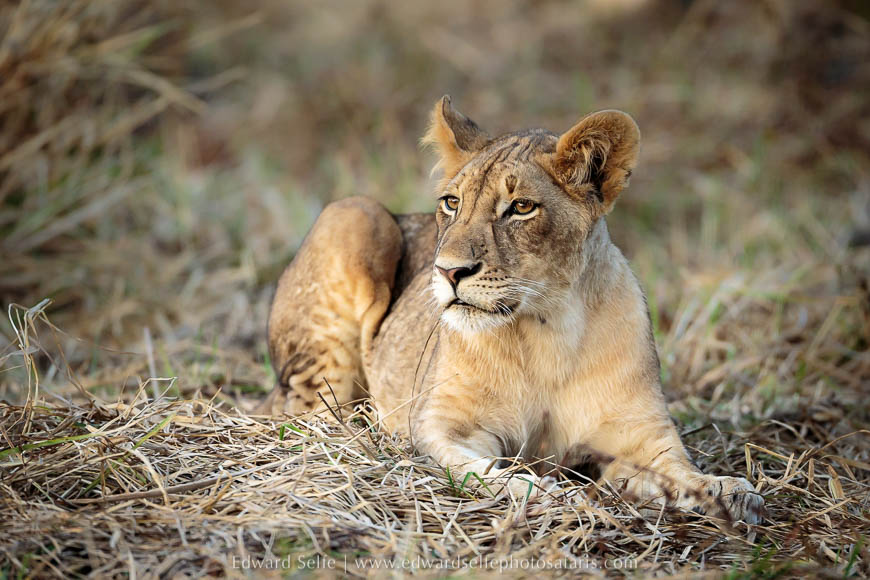
We spent an afternoon with the River Pride while they relaxed and watched (only watched!) a herd of waterbuck nearby.
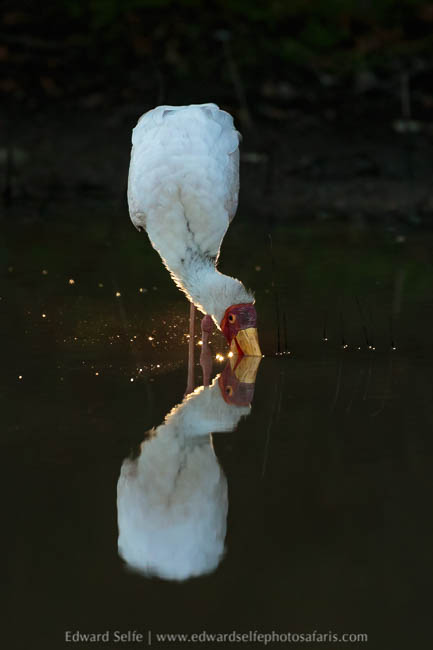
Some spectacular light effect on a yellow-billed stork caused specular highlights in the water around its bill as it fed in the shallow water.
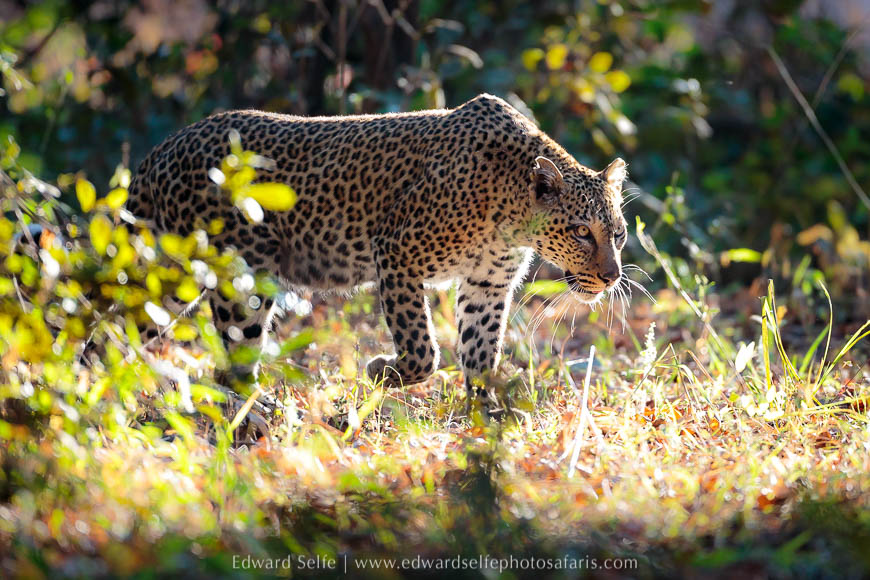
After a long search, over several kilometres, we finally tracked down a female leopard moving through her territory. It was very thick so I moved ahead of her and chose a spot where the light was coming through the trees and waited. She duly walked right through!
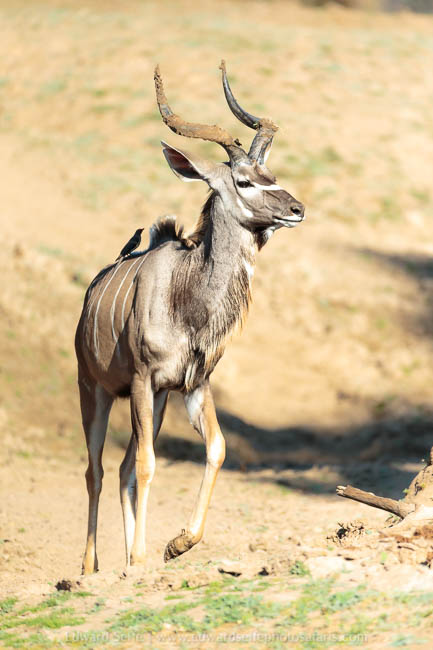
We were lucky that the wind was in the right direction when we waited at a waterhole for a herd of kudu to approach. We sat still, barely moving, while they got to the water’s edge…..and then walked past!
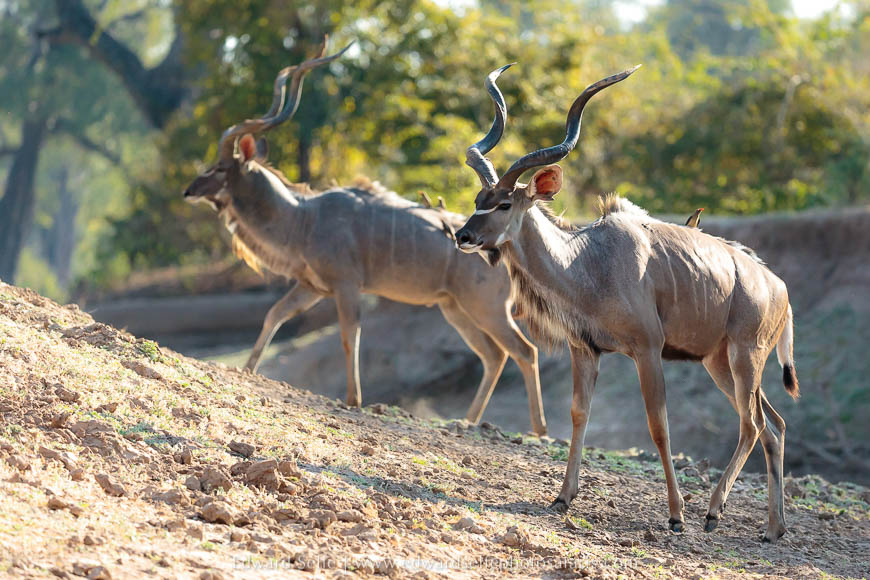
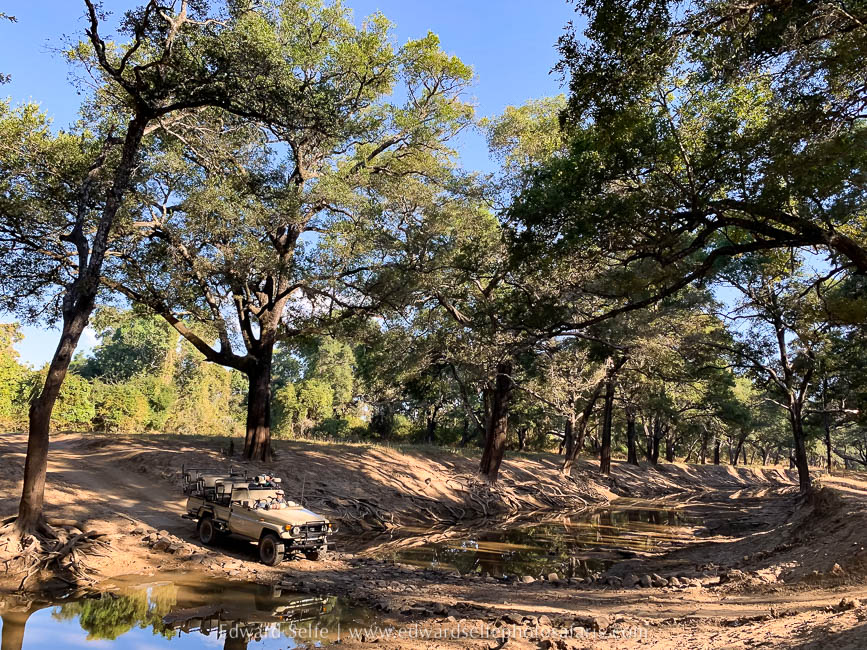
Time in the ebony forests is always valuable…
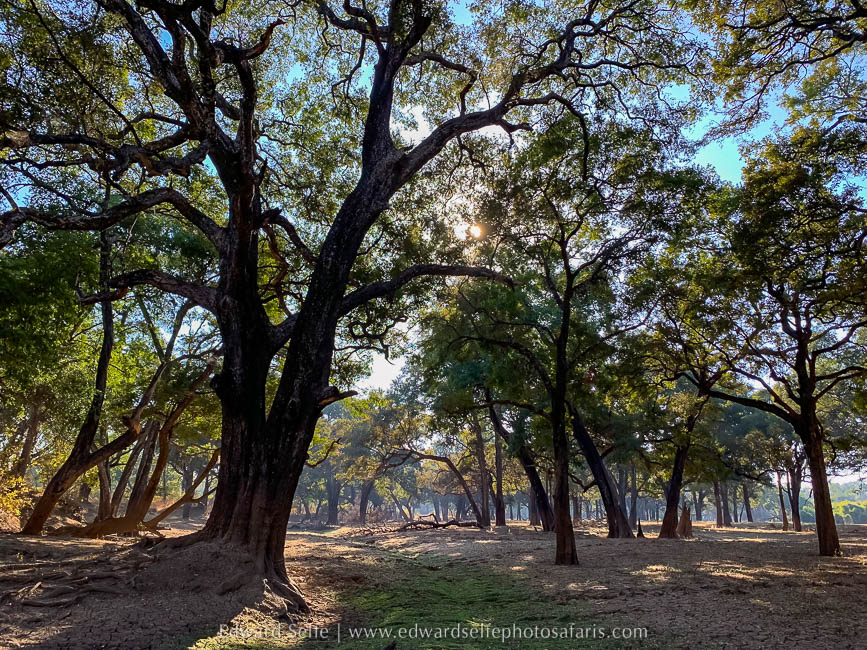
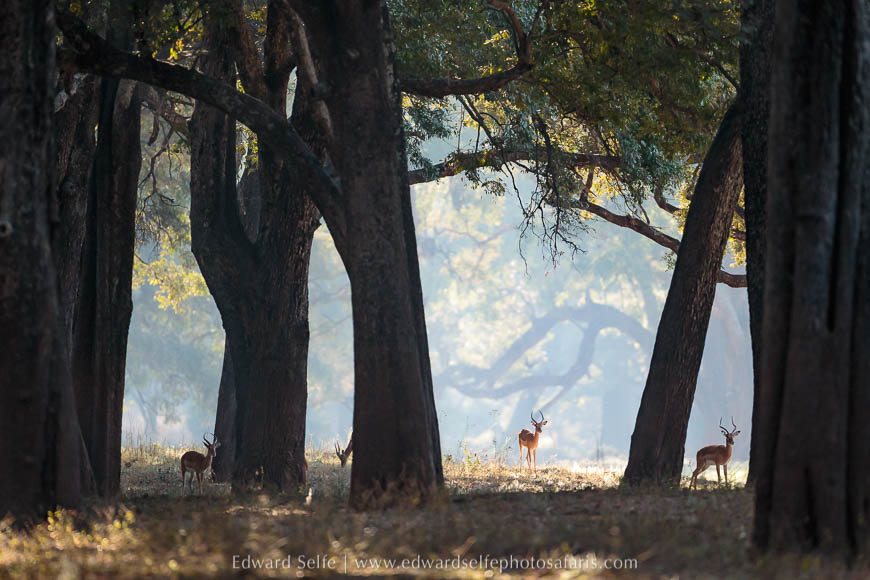
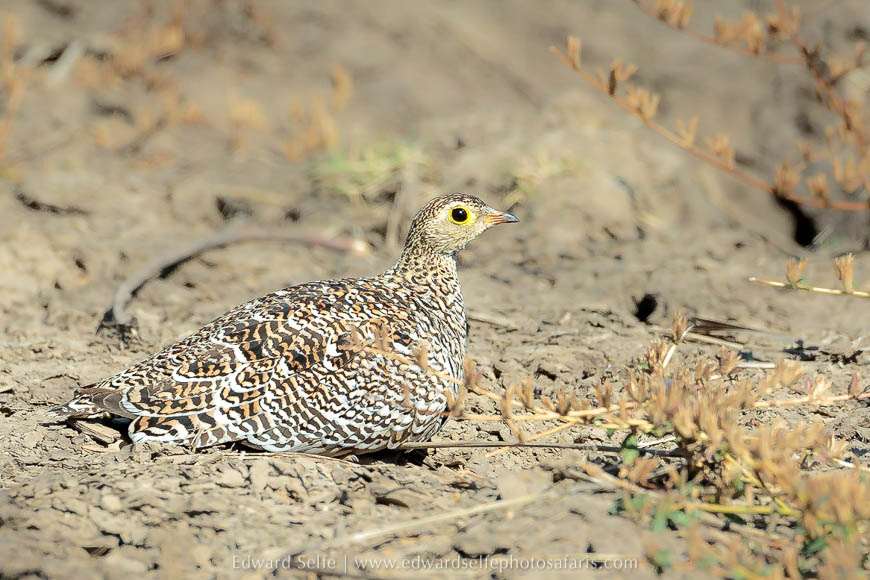
We passed a pair of double-banded sandgrouse every day on our way to Lion Camp’s entrance. They must be nesting nearby, but finding the birds themselves, with their cryptic markings, is hard enough, let alone spotting the eggs!
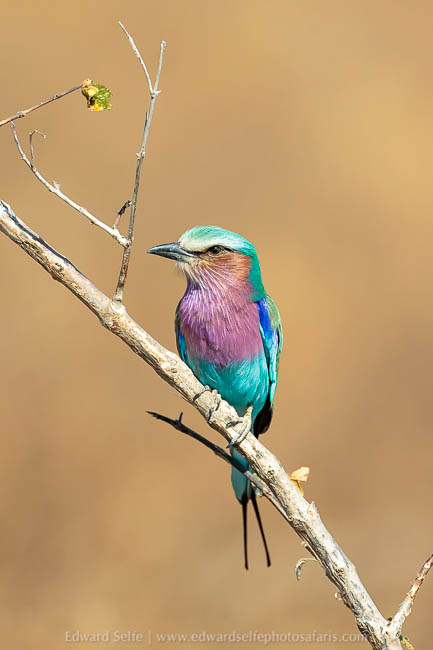
One bird that is much easier to spot is the ever-impressive lilac-breasted roller, one of Sue’s favourites!!
As is often the case with the Luangwa, Nature kept the best until the last day. We set out from camp, in search of the River Pride and to drive some roads that we had not covered before. We quickly found the lions in a sand river bed north of camp, and the cloudy overcast conditions meant that they were already active and moving towards a small group of waterbuck in the distance. We were able to park in the path of the lions, off to the side, but still far away from the waterbuck, and watch the lions stalk past us, apparently totally focused on their quarry.
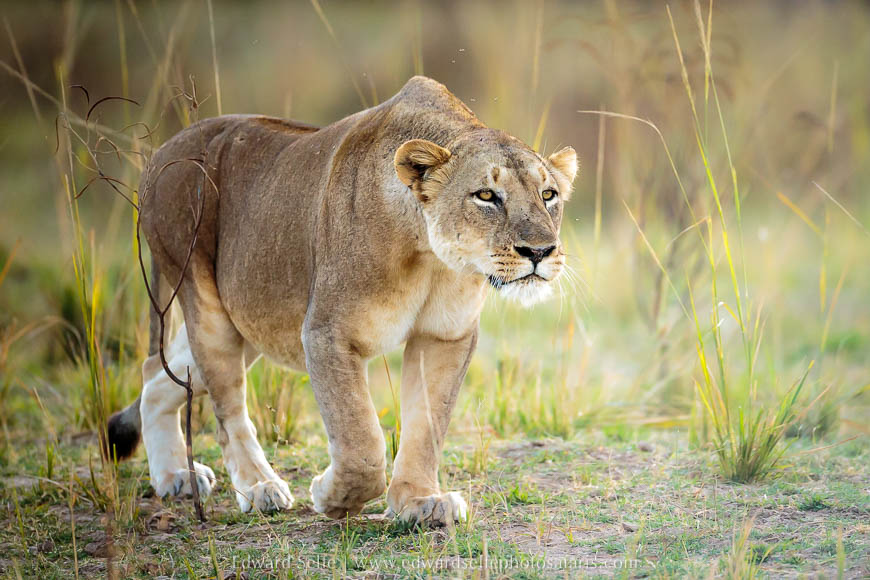
The pride split, with 3 females going around to the left and right, and 3 remaining as the trap into which the others would drive the waterbuck.
But, as is often the case with daylight hunts, it was a non-target species that gave them away; a spurfowl’s “kup – kup – kup” alarm call was enough to alert the antelope and, with raised heads, they soon saw the lions coming. However, they didn’t see the lioness that was circling them from behind, and she gave a short chase before giving up too. Our hearts were in our mouths and, even though we weren’t close to the action (to avoid disturbing the hunt), it was thrilling to watch.
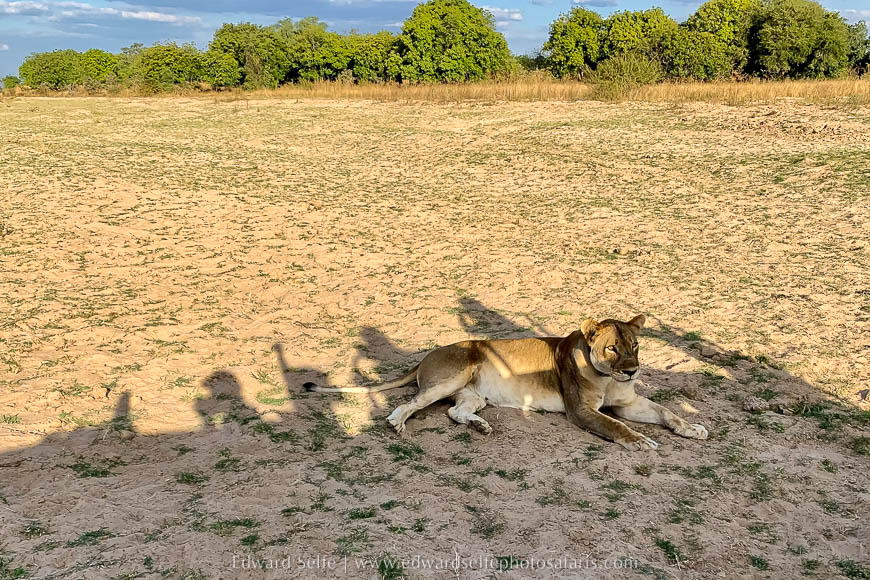
Tired from the hunt, and in the newly-emerged sunshine, the lead lioness took cover in the shade of our vehicle!
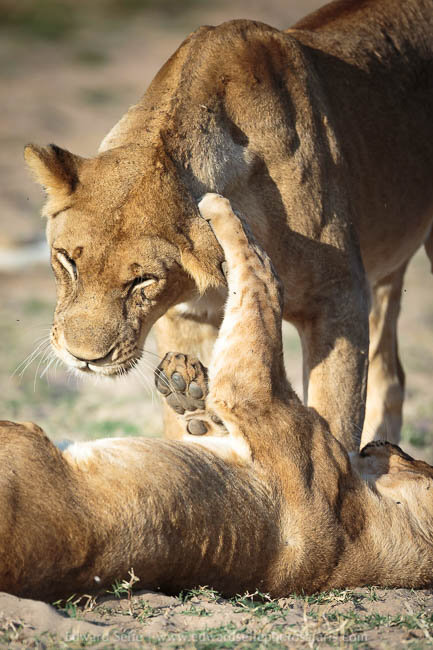
The female who had circled behind the waterbuck returned after all the others and was greeted playfully by her cub!
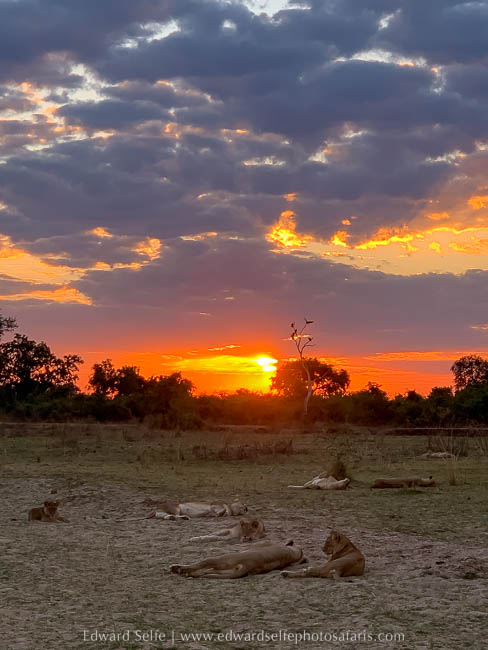
We sat with them while the sun set and then decided to leave them for a while….
When we returned, they were in the middle of crafting an ambush on a lone puku ram who was approaching the pride. We switched our lights off immediately and sat in the dark listening for clues. We used a dim, red-filtered light (which does not betray the locations of predator or prey) to illuminate the scene very briefly every few minutes to keep track of the action. The lions had basically surrounded a male puku, who was alone so had little chance of evading them, and then closed the net. We heard the lead lioness make a charge, and all the lions ran past our vehicle. Only when we heard the unmistakable sound of the puku being caught did we switch on the lights and discover that the kill had occurred just 50m behind our vehicle!
In these situations, we would all like to see the hunt in action. But our primary responsibility is not to alter the natural course of events. If we are able to see, we might be too close and we will likely affect the outcome in one way or another. As it was, we arrived at the scene, happy that we had taken no part in the outcome, around 20 seconds after the moment of impact. The lions were still fighting over the carcass, with one female gripping the throat of the antelope. This is raw viewing and not for the faint of heart (check out the video below if you want to see more) but it is what lions do on a daily basis for their whole lives. While gruesome and not “enjoyable”, it is a privilege to watch nature in one of these very brief moments where life and energy is transferred from one creature to another.
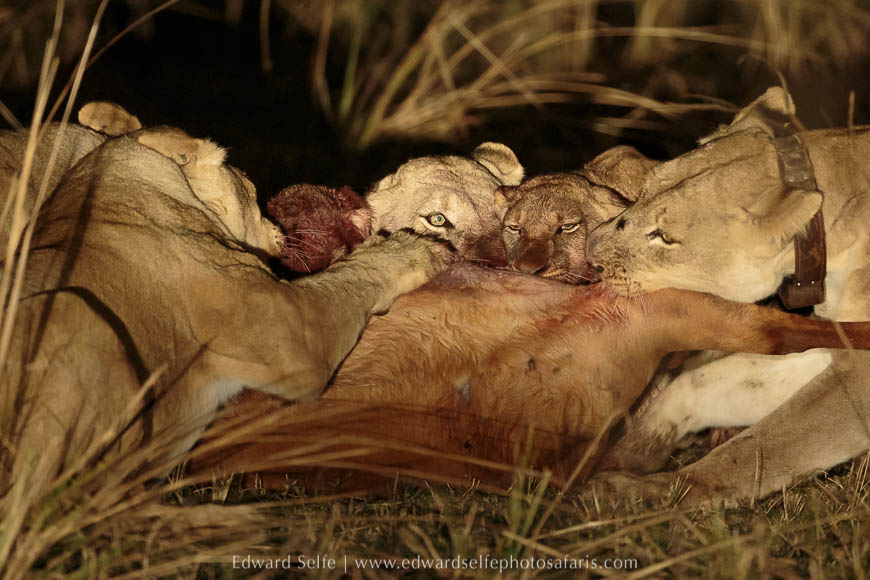
The energy, smell and noise is something to behold in these situations.
It was a quiet drive home that evening, as we all absorbed what we had seen. For me, to see a hunt or a brand new kill is a 2- or 3-times-per-year event so it’s always hard-hitting and thought-provoking. But also, once the moment is over and I do not need to stay totally focused, I allow myself the chance to relax and celebrate an incredible experience for my guests.
Anything that followed this lion sighting was going to be a bonus! But the Luangwa had another lovely morning for us. We went in search of leopard along the riverine strip, but were distracted by a huge group of zebra who were coming to drink at fish eagle lagoon. Numbering almost 50, in sub-groups of 8-12, we watched as more and more emerged from the thickets to drink and feed on the short grass.
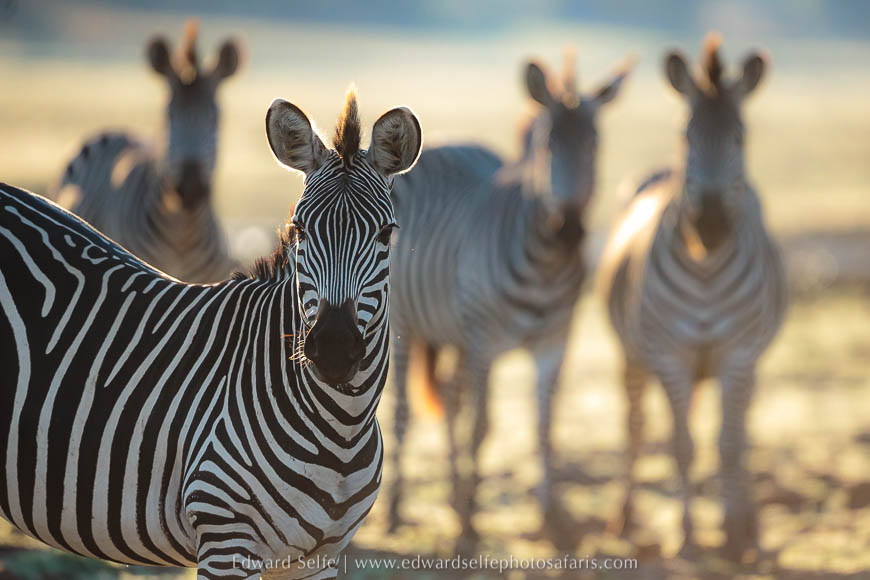
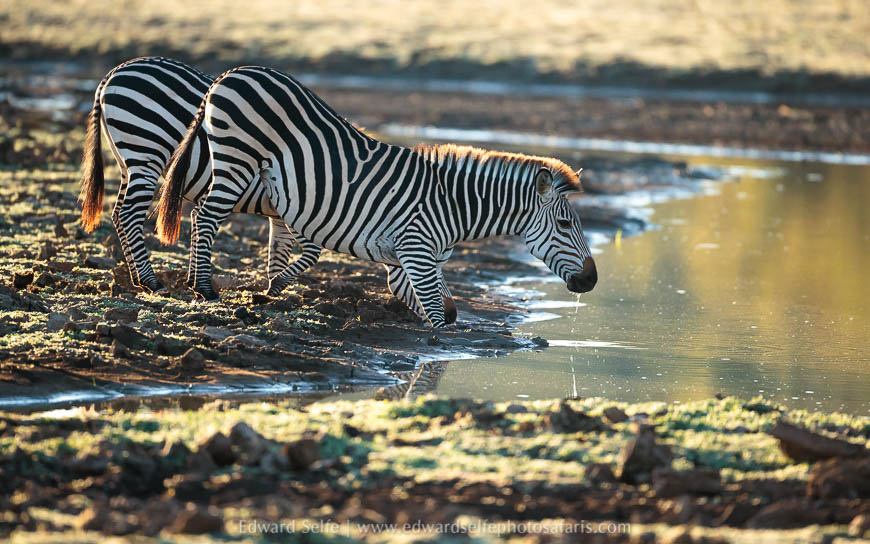
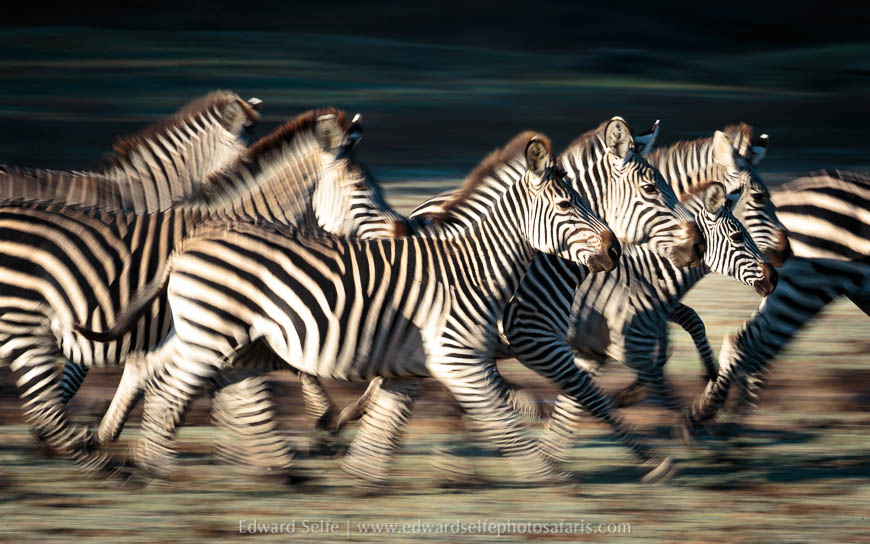
But that wasn’t all for the morning; stunning light on guinea-fowl and then an unusual observation with southern ground hornbills, where two females appeared to be chasing each other for more than 10 minutes in sustained flight, which is very unusual for them. I have contacted experts on this and will update here when I have suggested explanations.
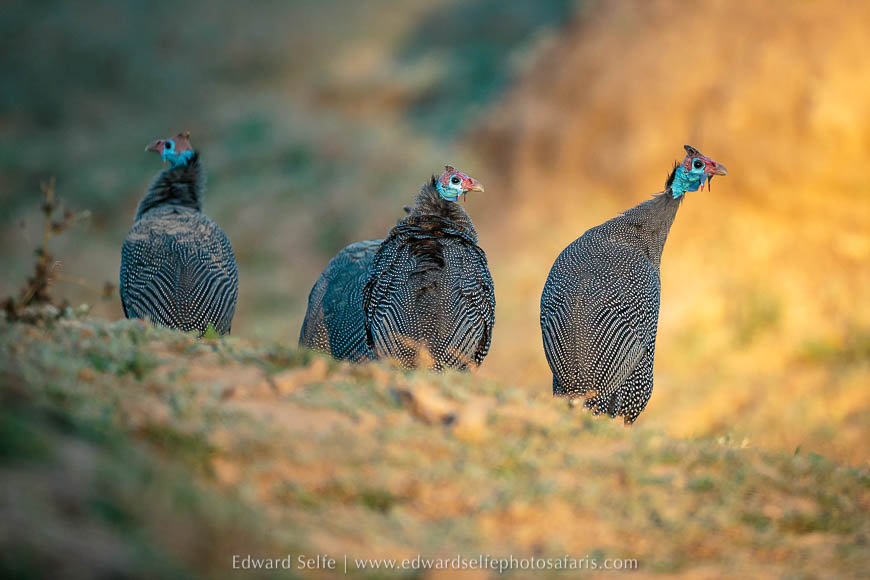
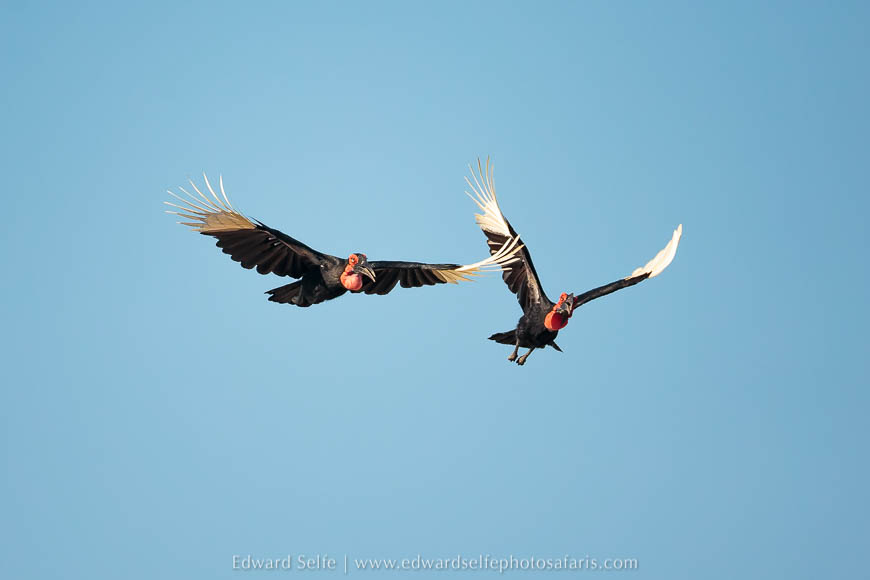
Ground hornbills fly strongly, but not usually for long periods or in pursuit of each other. I assumed that this was mating behaviour until I resolved that both were female, leaving me with great images but lots of questions!
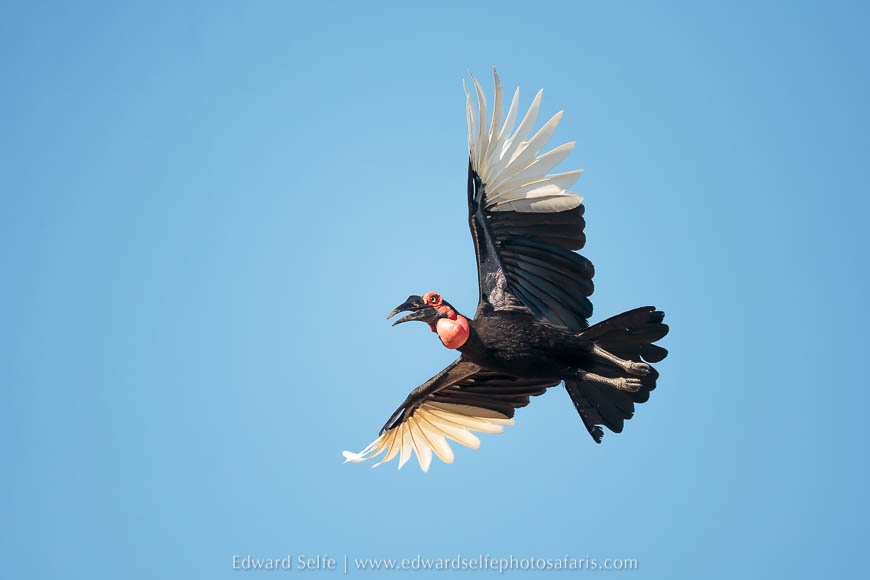
It had been a busy 2 weeks. Undeniably we were all tired from visiting 5 different locations and spending 9-10 hours per day on safari. But the sightings, memories, images and stories that we take away from it remain to be cherished.
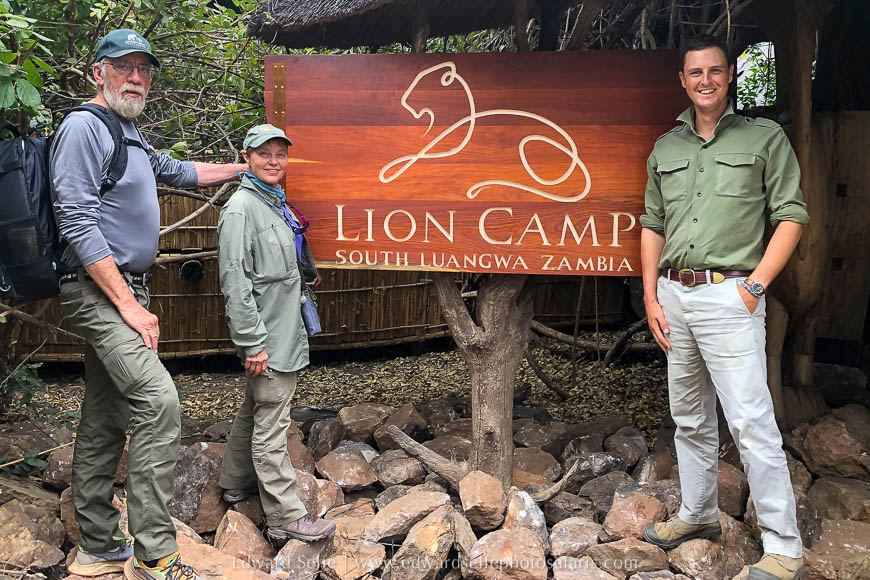
This had been a great trip. One of the best.
For some visual highlights, please enjoy this short video below:
Thank you, as always, for following and reading right to the end! But most of all, thank you to my guests for persevering in getting to Zambia and making the whole trip possible – it was truly a pleasure to share this trip with you.


